
 Illustrious, Formidable, Victorious, Indomitable (137-69)
Illustrious, Formidable, Victorious, Indomitable (137-69)WW1/WW2 RN Aircraft Carriers:
ww1 seaplane carriers | Ark royal (1914) | Campania | Furious | Argus | Hermes | Eagle | Courageous class | Ark Royal (1936) | Illustrious class | Implacable class | Colossus class | Majestic class | Centaur class | Unicorn | Audacity | Archer | Avenger class | Attacker class | HMS Activity | HMS Pretoria Castle | Ameer class | Merchant Aircraft Carriers | Vindex classAn introduction: Probably as famous for the Royal Navy the Yorktown class were for the USN, these world’s first armoured aircraft carriers were involved in quantities of operations in the Atlantic, seeing action afterwards in Pacific as well although their formidable resilience when facing the axis air power in the Mediterranean – and in 1944-45 against Kamikazes. They inspired armoured aircraft carriers both in the US and Japan as well: The Midway class, and IJN Shinano, while the USN even tried to exhange six Essex class for the entire Illustrious class. As the armoured CV concept started to lost its appeal, the Illustrious, Formidable, Victorious and slightly different Indomitable still served in the early cold war, and for the rebuilt HMS Victorious, until 1969.
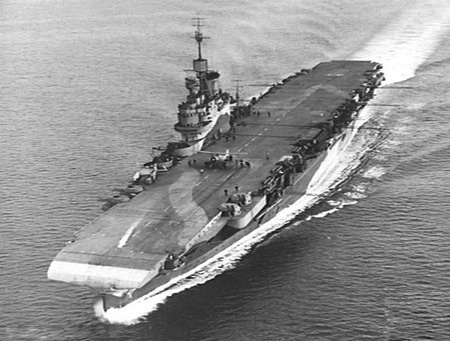
Genesis and design development
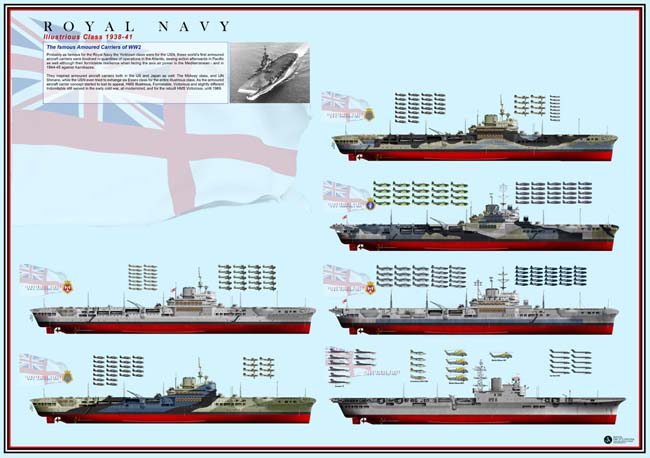
Illustrious class aircraft carriers poster – help support naval encyclopedia !
After HMS Ark Royal construction was started, in 1936, the admiralty naturally planned the next class, but knowing full well it was reaching its allocated tonnage for aircraft carriers. The Illustrious class however authorized, not under Washington nor London treaty, but now within the restrictions of the Second London Naval Treaty of 1935 which limited carrier size to 23,000 tons (but enabled more global tonnage). They were different in conception to the HMS Ark Royal as well as the Yorktown and later Essex class in what they opted for a better approach to AA defense, both active and passive (protection). Built between the Yorktown and Essex, they also included provisions for future wartime upgrades (without treaty limitations, as were the Essex class, triggering the revised Indomitable, the wartime Implacable class, and following, like the impressive Malta class, shadowing the USN Midway.
The admiralty in 1936 wanted to improve survivability instead of continually raising the capacity of the ship, its ability to carry larger air groups. It was based on the assumption (which proved correct) of the strongest supporters of naval aviation, that even with the best organization and skilled, the air group’s own defensive net could not prevent enemy planes to get through, and attack the carrier itself. In that case, the carrier needed a better combination of active (AA) and passive (armour) defenses in order to survive, in conditions that would probably cripple other vessels. Indeed what was the use of an air group deprived of its carrier in battle ? From there, the admiralty was caught between the need of a larger air group, which in the case of a better armed carrier would only meant increasing the tonnage, so beyond the treaty caps, which was impossible at the time. Until then, British carriers were caracterised by their smaller air group compared to USN carriers, with the Ark Royal being a notable exception.
Therefore it was decided to sacrifice the air group (with consequences such as the design of more versatile carrier-based aircraft suh as the Fairey Fulmar and others), while increasing survival. While other carriers had armour on the lower decks, hangar/main deck, an inheritance of 1920s conversions from armoured ships, the British admiraly understood the real danger was inside the hangar, not below. Indeed the hangar contained live ammunitions and rich, volatile high-octane gasoline that needed little to start a crippling serie of incendiary explosions. The HMS Ark Royal had two hangars, but both were unprotected against even small bombs.
This sacrifice meant enabling larger hangars and a better air group, ensuring a better long range active protection, however it ws decided this USN tactical thinking of CV use was bot the result of 100-foot-longer US designs (Torktown in that case) and operational doctrine. The latter allowed for a permanent deck park to augment the hangar capacity. It could be usable in the Pacific but was much more difficult in the north sea and nort atlantic where the conditions were quite rough. Again, scenarios played showed a smaller air group, composed of more versatile planes was preferrable if enabling a better protection. This was a gamble, later proven right, but the admiralty had no way of knowing if aviation would be powerful enough to create a “steel wall” before entering the carrier close defence bubble. In 1936 indeed, the naval fighters available were the versatile Hawker Nimrod and Osprey. The Gloster Sea Gladiator, a modified Mk II developed for the Fleet Air Arm would not enter service before late 1938 and the next year, the Roc and Skua, other jack of all trades.
Design of the Illustrious class
The Royal Navy of the mid-1930s wanted to build a carrier capable of sustaining air attacks and continuing air operations after substantial battle damage. It was to be able to protect its air group, but still have the latter large ebough to provide fleet reconnaissance, trade protection, local air patrol and combat strike duties as any carrier. And all this was to be done withing the treaty limits, a daunting challenge if there was one. Therefore, the choice was made of an ingenious and for the duration of WW2, Top Secret design feature, the “armoured box” hangar. It was to be both a strength deck and flight deck. This came as a double cost engineers needed to remedy: Stability, caused by this extra top armor, and the size of the air group. One solution was also to marry both the flight deck and top of the “armoured box” as part of the structure, providing considerable weight savings, and of course renouncing a second hangar as in Ark Royal. It was calculated the air group was to be down to 33 aircraft at the most, with consequences for the air group composition and type specifications (see later).
As precised at the time by Sir Denis Boyd, first captain of HMS Illustrious:
“The history of the Illustrious design as far as I am concerned was that I formed a committee of the brightest naval officers at the Admiralty to study the Navy of the future. We were in a fury because we thought we were building the Navy of the past instead of the Navy of the future. Our idea was that the carrier was the prime fighting ship. In all this the Constructors were most sympathetic and helpful. The Controller Henderson was not.”
So as established in 1936, instead of a large air group used as primary defence, a consequent, above average anti-aircraft armament would be the active defence and the “armoured box” concept the passive defence, resulting in a reduced aircraft complement. This resulted in HMS Illustrious’s hangar being 82% as large as USS Enterprise’s but she carried 30% of her aircraft capacity on her deck. The next armoured CVs of the Indomitable class had two hangars actually larger than USS Enterprise but less aircraft as she had no permanent deck park. Only by 1945 a permanent deck park was carried as per a new doctrine to standardize their use with the USN in the Pacific, up to 57 aircraft in the single hangar Illustrious and up to 81 on the Implacable, still less than the 110 on the unarmoured Essex class. But facing Kamikaze the difference was quite perceptible as almost three Essex-class were almost destroyed and had to be withdrawn for repairs until V-Day.
Hull, hangar and protection scheme
The hull of the new carriers was close to the Ark Royal, based on a 23,000 long tons (23,000 t) standard displacement, compared to 22,000 on Ark Royal’s. Their hull measured 740 ft (225.6 m) overall and 710 ft (216.4 m) at the waterline, so shorter compared to the 721 ft 6 in (219.91 m) waterline of Ark Royal, but the latter overall went up to 800 feets (240 m) thanks to an extended overhang for her flight deck. The Illustrious were beamier too for stability, at 95 ft 9 in (29.2 m) versus 94 ft 9.6 in (28.895 m) and with more deep draught, also combined with a lower height to increase stability. Draught was indeed 28 ft 10 in (8.8 m) (deep load) versus 27 ft 9.6 in (8.473 m).
Protection-wise, armour was carried at flight deck level, strength deck 3-inches thock (76 mm) (a revolution as the armoured deck was carried just above waterline level for stability reasons). Combined with itrs bulkheads, similar to a battleship citadel, it formed and armoured box-like hangar, integral part of structure. That marriage of structure and armor was not new, the Japanese knew it and tested it already in the 1920s thanks to chief engineer Hiraga. This was only made possible without increasing displacement by limiting height to 16 feets (4.88 m), even 14 ft (4.27 m) on the Indomitable class, compared to much roomier the 17 feet 3 inches (5.3 m) of the Essex class, even 20 ft (6.10 m) in Saratoga. In fact in the latter it was possible to keep spare parts and entire dismounted aircraft strapped under the ceiling or to lift by gantry a disabled plane across the hangar, above the parked ones. All this was impossible on the British carriers and also limited the size of aircraft carrier due to their folded wings tips and tail height. For example, the Avenger Mark I was condemned to be carried on deck only, and the Corsair Mk.I had its vertically folding wings practically scrapping the paint of the ceiling. This also severely restricted operations with jets post-war.
Main belt protected about 30% of length by waterline. Main belt amidships was taken to the hangar deck and to the flight deck on the starboard side abreast island. 9m ends of main belt were taken to the upper deck only. Hangar sides were protected on full hangar length. 62% of flight deck (over hangar) had 76mm armour, another part of flight deck was 38mm. Hangar deck has 76 – 64mm thickness between ship sides and hangar sides and 25mm inside citadel. Lower deck was 76mm aft. Lifts were not armoured. There were 38mm anti-torpedo bulkheads. 4.1m deep underwater protection can resist exploding of 340kg TNT.
The previous HMS Ark Royal was protected by a belt: 4.5 in thick, a classic armoured deck of 3.5 in (8.9 cm) over boiler rooms and magazines, and compartimentation for ASW defence. The Illustrious class on the other hand kept the same Waterline belt of 4.5 in (114 mm), combined with a comparale magazines protection ranging from 3 to 4.5 in (76–114 mm). However the armoured box of the hangar had a 3 in (76 mm) flight deck/roof, with bulkheads 4.5 in (114 mm), as thick and sides of the hangar. There were 3-inch strakes on either side, extending from the box sides to the top edge of the main side belt.
The latter protected all the vitals of the ship, including ammo stores and igh-octane aviation gasoline tanks. This main armour covered 62% of the flight deck, weighing 1500 tons. Much of the remainder was toughened structural steel. 3 inches looks weak, especially against AP tipped bombs, but their velocity was not as good as shells, and the steel used had a special treatment making it more resilient, comparable to the US STS as well (high carbon content, sandwiching a “softer” steel – still quite hardened). In fact, it was calculated to withstand a 1,000 pound bomb (and heavier ordnance striking at an angle). This proved enough to deal with any carrier-based dive bomber payload at the time, and stayed that way in WW2. As quoted by Brown in “D. K. Nelson to Vanguard: Warship Design and Development 1923–1945”, “The structural design was a magnificent feat of engineering, reflecting great credit on the assistants, Sherwin and Stevens”.
Facilities: Lifts, catapult, arrester gear
Facility-wise, the Illustrious class had a single catapult forward, port side and two rectangular 45ft by 22ft lifts, in the axis of the ship, fore and aft. They could carry 13,440lb in a 30-second cycle, later upgraded to carry 15,000lb. They were so reduced as to only carry small folding wings models. But this deliberate design choice limited the entry of debris and flamable materials from the deck and ensured a better integrity of the strenght deck in general. Both lifts were placed at each extremity of the “box”, not inside so as not to hamper aircraft moves inside the hangar. The planes accessed the armoured box through sliding armoured doors of the bulkheads. Around it, outside the box, the flight deck around the fore and aft lifts was still rated as 1.5in armour. That way if needed, both doors could be closed during an attack and completely seal the hangar as a “cocoon”, sheltering for anything happening above it. Quite a morale booster for the personal working to prepare the planes inside the hangar.
The Illustrious were designed with stronger arrester systems, to absorb the greater weight of expected aircraft model evolution. On previous aircraft carriers, old-gen arresters failed with new models, or were missed. It was realized a method of last resort was needed to prevent an aircraft from slamming into parked aircraft forward or even dropping (and possibly exploding) through the elevator. Therefore, Illustrious class’s MkIII arrester set installed was first trialled in Courageous in 1931. On Ark Royal this system was proved able to stop 8000lbs at 60kts. After modifications it was on Indomitable able to stop 11,000lbs at 60kts. On the Illustrious, six wires wee fitted aft and amidships, positioned much further forward as compared to US practice and during the war, two more arrester wires were added aft of the lift as the round-downs were flattened. HMS Illustrious was the only one in her class, not to have a pair of arrester wires positioned forward of the island for emergency deck landings over the bow.
The catapult comprised a central brace system chosen for trolley-launch seaplanes as well as distributing the forces of launch evenly through an airframe. It had four collapsible gripping arms, quickly stowed away from the deck. However adjusting the length of these arms to suit different aircraft types was a long process, and the Aircraft also needed four attachment points. The US system in contrast just required a wire strop looped from a rolling shuttle for the connection to two attachment hooks. The British trolley system was as a result more complicated and slightly slower at 40 second average launch interval, less suited for high intensity operations. The catapult was designed to launch 11,000lbs at 66 knots and after wartime modification, reached 14,500lb with the American-style tail-down method. It was modified in 1943 to operated US-supplied lend-lease aircraft.
In fact, unassisted take-off was still faster, especially with a well trained air and deck crew. An aircraft could be in the air every 10 seconds with this proven method. The accelerator however allowed more aircraft to be parked on deck, allowing larger strike groups. It could be useful in a low-intensity operation when the CV acted as a plane carrier essentially, but it seldom happened at all. A design with two such catapults was also originally studied for the Illustrious Class, but dropped due to the narrow forward section. Planes were way too close for comfort. Even after squaring the flight deck ends in wartime, no consideration was given to adding a second catapult.
The “aerodynamic” form of island and funnel in the form of a profile of a plane wing, and also the round-downs of the deck became feature of architecture of Illustrious: it was supposed, that it will decrease the turbulence of air and will improve conditions of take-off and boarding of aircrafts. At the same time round-downs shrank deck effective length to 189m, therefore on the subsequent aircraft carriers, since Victorious, round-downs began to fulfil not such big, that has allowed to extend its deck to 204.2m. The AA armament repeated accepted on Ark Royal, but with new 114mm so-called “inter-decks” mountings.
Powerplant
Nothing really innovative here. It was very comparable to Ark Royal’s machinery, albeit more powerful due to the tonnage difference. The Illustrious class was propelled by three shafts connected to Parsons geared steam turbines, fed by 6 Admiralty 3-drum boilers for a total of 111,000 shp (83,000 kW) (102,000 for Ark Royal). Top speed as specified was 30.5 knots (56.5 km/h; 35.1 mph), like the previous design and range was 10,700 nmi (19,800 km; 12,300 mi) at 10 knots (19 km/h; 12 mph), also comparable (7,600 nm at 20 knots). As usual, turbines and boilers were all separated in enclose compartments to prevent any flooding disabling the ensemble. The ships were still able to keep some power after a torpedo hit. Like on Ark Royal, there was a three-layer side protection system using a void-liquid-void sandwiched scheme designed to protect against a 750-pound (340 kg) warhead torpedo blast.
Armament
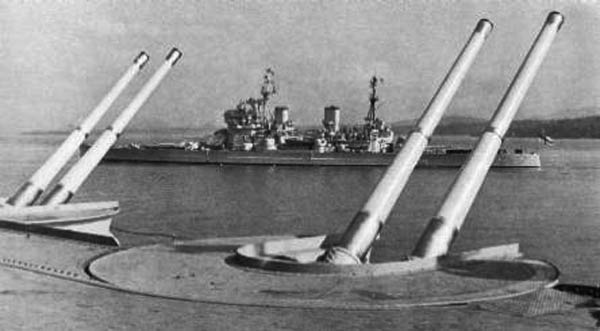
Another strong point of the design, but not especially innovative as it was a repeat of the Ark Royal’s armament, consisting in eight twin QF 4.5-inch dual-purpose guns in turrets placed in sponsons at the angled of the hull for and aft. It was completed by six octuple QF 2-pdr anti-aircraft guns, mostly grouped around the island, fore and aft and on the opposite side abreast the flight deck. This was much better standardized than the Ark Royal’s odd combination of four quadruple 2-pdr (40 mm (1.57 in)) AA guns and eight quadruple .50 in (12.7 mm) AA MGs. During the war, this AA was extended by extra 40 mm Bofors (US-pattern) and 20 mm Oerlikon placed in new positions alongside the flight deck (see later).
4.5 in QF
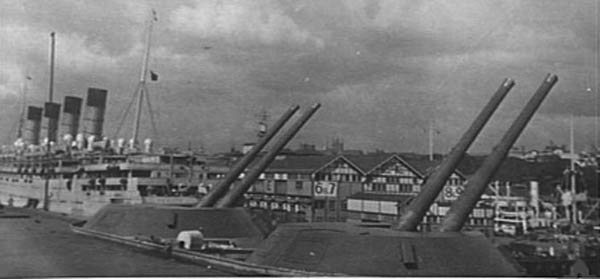
These were the Mark III in twin mounting BD Mark II, firing a 55 pounds (24.9 kg) fuse HE shell and using an Horizontal sliding block with +80° elevation, 360 traverse, 16 RPM at 2,449 ft/s (746 m/s), max range of 20,750 yd (18,970 m) at 2,449 ft/s (746 m/s) and 41,000 ft (12,500 m) ceiling.
2 pds QF AA
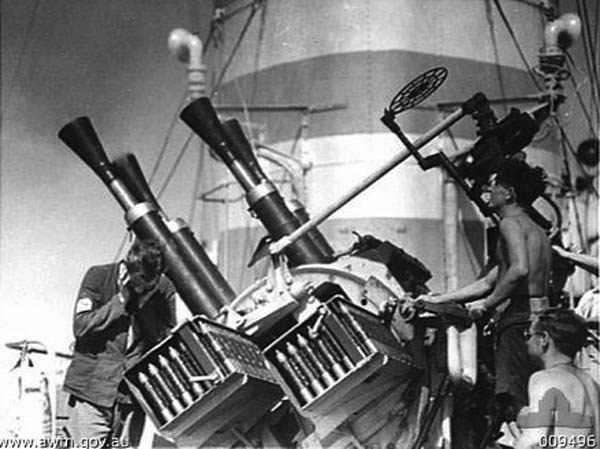
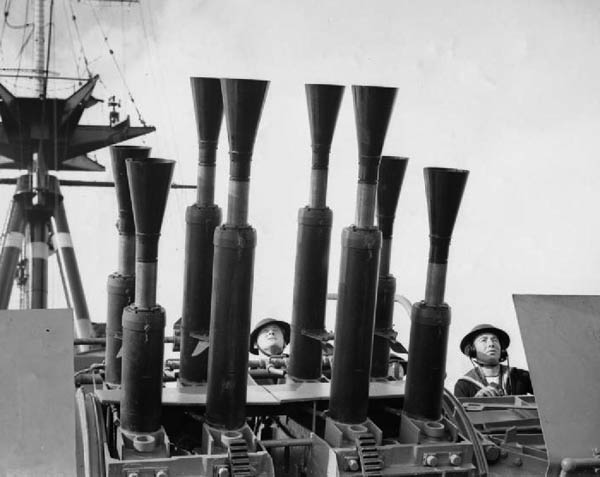
The classic octuple mounts also found throughout capital ships and cruisers. For a “reduced” space, they offered quite a firepower. The Calibre was 40 mm L/39, with a shell Weight of 2 lb. (980 g) or 1.8 lb. (820 g) for the lighter High-Velocity (HV) round. The Rate of Fire was 115 rpm, fully automatic with an effective range of 3,800 yards (3,475 m) or 5,000 yards (4,572 m) for the HV round. Effective Ceiling with the same was 13,300 feet (3,960 m) and muzzle Velocity was 2,040 ft/s (622 m/s) or 2400 ft/s (732 m/s) for HV.
Air group
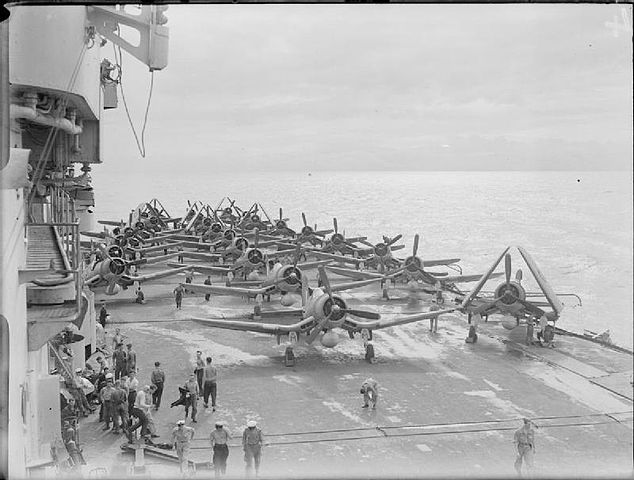
Corsair Mk.I onboard HMS Victorious during the raid on Sabang, 1945
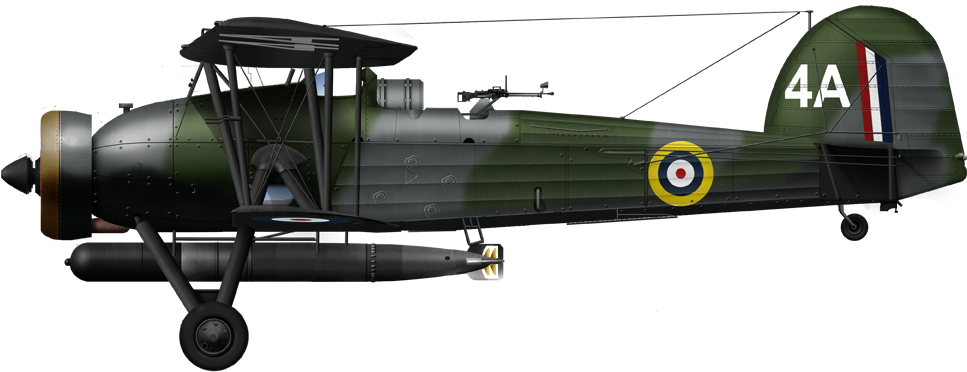
Swordfish Mark I of 815 NA Squadron (HMS Illustrious), Lt Cdr Williamson, Lt N Scarlet, raid on Taranto, 11 November 1940. Other participated in the hunt for Bismarck.
Due to her recent admission in active service in WW2, the class had had the latest and best of what Fairey could offer, starting with a squadron of Fairey Swordfish, and two others of respectively, Blackburn Skua and Fairey Fulmar. Her first air group reached 33 aircraft, all contained witin her sole hangar. There will be little change for all four ships until 1942-43, and a lot after mid-1944 (see later).
Fairey Fulmar (1940)

Fairey Fulmar Mark I, R (N1985), 806 NAS FAA, HMS Illustrious, circa 1940 (author’s illustration).
The Fulmar was essentially navalized version of the RAF Fairey Battle. Altough long it was only a two-seater, but multipurpose, intended for reconnaissance, ground attack, and fighter. Its RR Merlin VIII made it better than the Battle but it never was a good fighter. Of the 600 built, most were phased out in 1943 as the Firefly arrived. The HMS Illustrious deployed them first in the fleet, and they helped spotting the Bismarck, escorting Malta convoys, raiding Petsamo in Finland. They equipped twenty squadrons, on the eight main fleet carriers of the Navy.
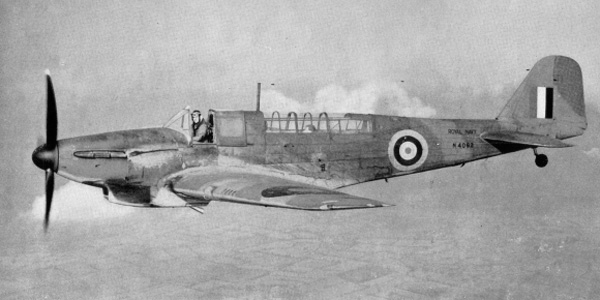
Blackburn Skua (1938)

Although the most modern FAA plane when introduced from November 1938, it was deployed in 27 squadrons. Slow and of course multirole (fighter and all the rest) due to the British small air group policy, in was garadually phased out as obsolete in mid-1941.
Grumman Martlet (1940)
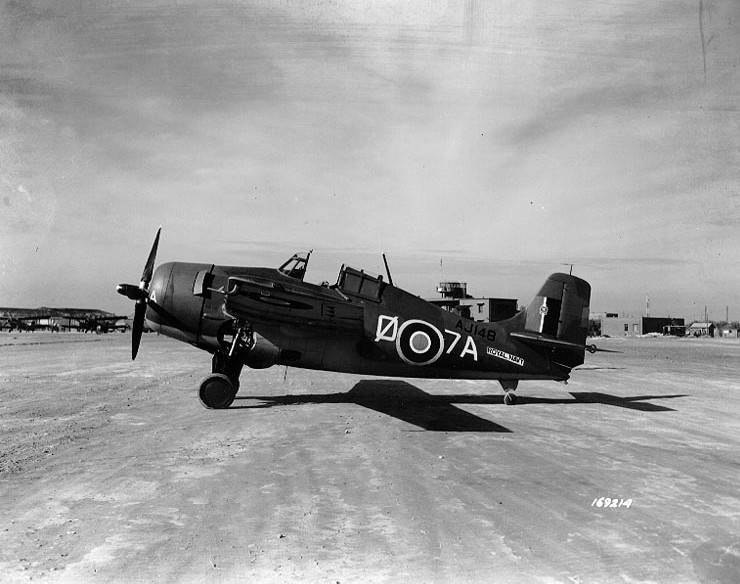
Martlet Mk.2 from 888 Sqn, HMS Formidable, operating inland in Oran AB, December 1942.
The British name of the Grumman Wildcat. Obtained by lend-lase as ordered were placed in early 1940 (The French models were delivered to Britain as per the capitulation of June), and thousands were delivered, from the Mk.1 to the Mk.V. From the Mk.VI it was called “Wildcat” and no longer Martlet for better standardization in Pacific operations. In fact the first came from the late 1939 French order for 81 intended for their Joffre-class aircraft carriers. They had specifics tailored for French pilots as well as all metric instruments onboard. They were subsequentely modified for British use by Blackburn and the first entered British service in August 1940, 804 Naval Air Squadron Hatston (Orkneys) and condemned to land bases at the exception of the non-folding wings six 882 Sqn aboard Illustrious, from March 1942. In April 1942 they were transferred to HMS Archer. The 10 others were Belgian, also modified as Martlet Mk 1s. The Mk.2 at last had folding wings, 100 ordered, not delivered until August 1941. The Mark III were 30 ex-Greek AF fixed wings F4F-3As later transferred to the FAA. The largest order was 220 F4F-4s, renamed Martlet IV, and later 312 FM-1s in early 1944 followed by the FM-2 Wildcat (Mark VI).
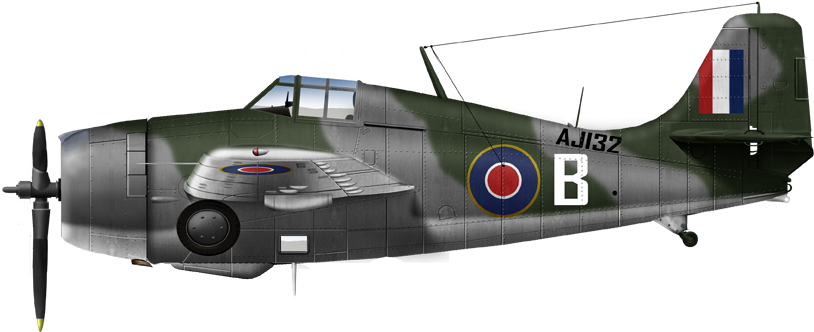
Martlet Mk.2 from 881 Sqn, HMS Illustrious, Operation Torch November 1942 (author’s).
HMS Illustrious also operated the Sea Gladiator (1941) as well as the Blackburn Roc fighter, and from 1942, the Swordfish were gradually replaced by Fairey Albacore She also operated a single Walrus flying boat for laison and reconnaissance. From 1942, HMS Formidable operated Grumman Martlet fighters. HMS Victorious in addition of the latter flew the Sea Hurricane and the Buffalo Mk.I, at least for a short while. From 1944, they received the Hellcat, the Seafire, the Barracuda, the Avenger, and in 1945 the Firebrand and Firefly.
HMS Indomitable swapped right away in May 1942 to an air group composed of 12 Fairey Fulmar, 9 Sea Hurricane and 24 Albacore. By late summer, the Fulmar were discarded and replaced by 10 Martlet and in May 1943 her air group only comprised 40 Seafire and 15 Albacore as gradually air defence took priority. In the next summer of 1944, she only operated 48 planes, 24 Hellcat and 24 Barracuda, then by December, this changed again for 29 Hellcat and 21 Avenger and in early 1945 was back to a three model type air group with 69 planes (by then parked on the main flight deck): 40 Seafire, 9 Firefly and 20 Avenger. Two month later, the Seafire were unloaded and she was back with a “Pacific air group” or 33 Hellcat and 15 Avenger. Back home in December, she had a reduced training all-British park, of only 24 planes, 12 Sea Fury and 12 Firebrand, the last and best piston fighter-bombers of the FAA. HMS Victorious of course was rebuilt after her 1958 reconstruction she operated a colorful 36 aircraft strong air group alternating the Sea Hawk, Sea Venom, Wyvern, Skyraider, Gannet, Avenger warning model, Whirlwind and the helicopter Sycamore.
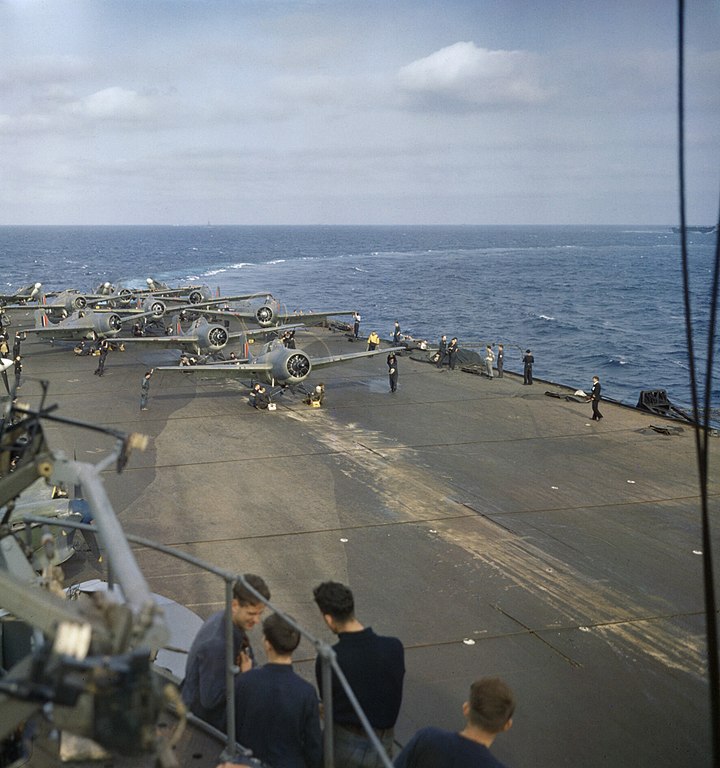
Martlets and seafire ready to, take off, Operation Torch, nov 1942.

Fairey Albacore taking off HMS Indomitable, Med. August, 10, 1942
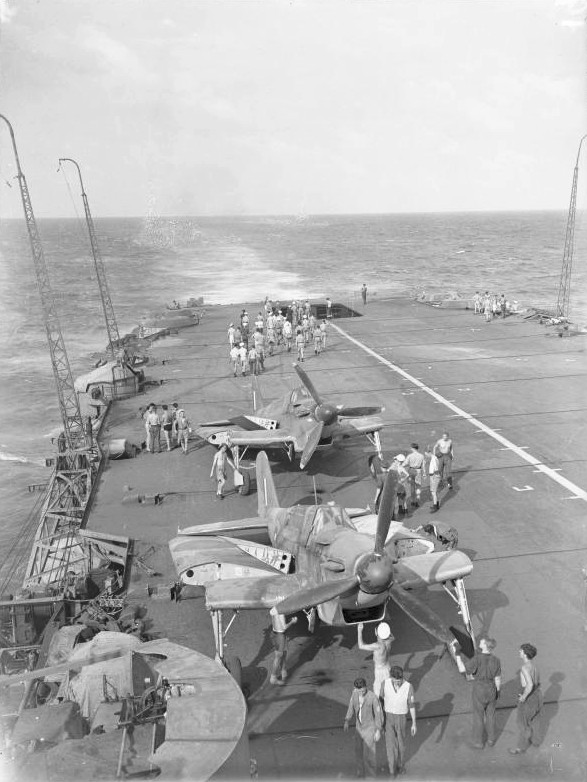
Fairey Fulmar prepared to take off for Operation Ironclad, Madagascar, April/May 1942
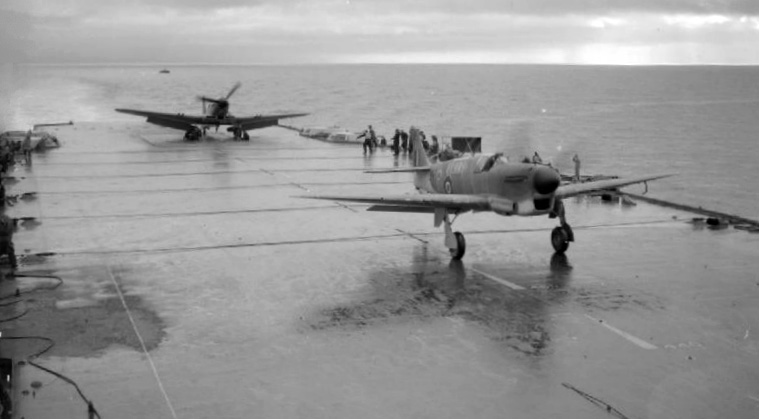
Fairey Firefly taking off from HMS_Illustrious – IWM
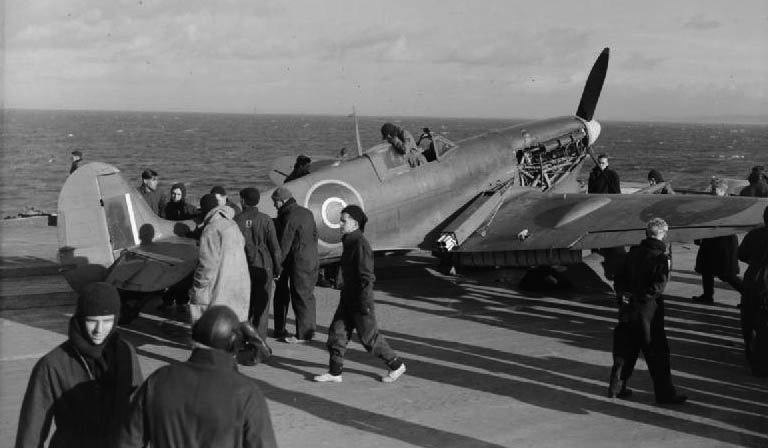
Seafire from HMS Illustrious, 1944
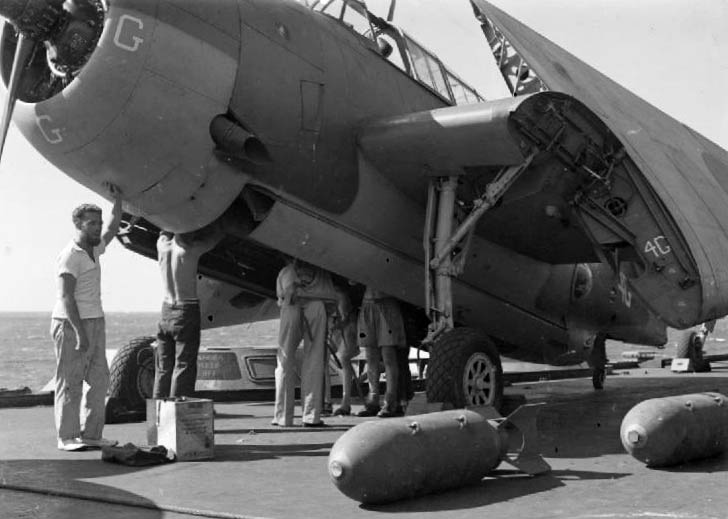
Avenger being armed on HMS Illustrious, 1944
Wartime Modifications
In fact, during the early war years, extensive “round downs” on the bow and stern were added to improve air flow and all three had flight deck rebuilds to increase their flight deck space with the usable length of HMS Illustrious reaching eventually 740ft versus 620ft as built. The flight deck however was still 38ft above the water level, not so much in case of very heavy weather. Deck planes needed to be protected by tarpaulins. The flight deck as designed was enough to operate 11,000lbs aircraft, up to 14,000lbs, and steadily upgraded.
HMS Illustrious:
While under repair in 1941, Illustrious’s rear “round-down” was flattened to reach 670 feet (204.2 m) and her aircraft complement reached 47 aircraft with a permanent deck park of 6 aircraft. Light AA armament was augmented by 10 Oerlikon 20 mm in single mounts. Protection-wise, the two steel fire curtains in the hangar were replaced by asbestos ones. Late 1941, her Type 79Z radar was replaced by a Type 281 in addition to Type 285 gunnery radars mounted on top of her main fire-control directors. Between all this her crew rose to 1,326.
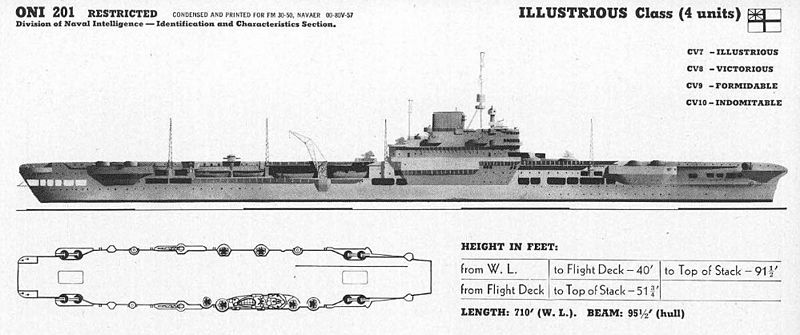
Recoignition drawing
After her 1943 refit, her flight deck was extended a second time, to 740 feet (225.6 m) with outriggers added, ‘U’-shaped beams extending from the side of the flight deck to park the aircraft tailwheels. This allowed more aircraft to be stored on the deck. More 20 mm twin mounts were added and by May 1943, the total was 18 twin and two single. The main radar became the Type 281M, plus a single-antenna Type 79M. Additional Type 282 gunnery radars were also adopted to direct the “pom-pom” directors and Type 285 radars for the DP guns. Also her bridge was adorned with a Type 272 target-indicator radar. With an aircraft park of 57 the crew reached 1,831.
Her last refit was intended for the Pacific: In mid-1944 her starboard octuple “pom-pom” mount abaft the island was replaced by two 40 mm Bofors, two more twin Oerlikon mounts were also added. Her worn-out boilers were retubed. No change for electronics. The crew reached 1,997 which lacked proper accomodations. In 1945 her battle damage and general wear-and-tear caused her machinery vibrating severely. It was so bad for her centre propeller shaft that the propeller was removed altogether, the shaft locked in place. But vibrations remained so bad HMS Illustrious rarely passed 24 knots. This was one of the reasons which saw her not chosen for reconstruction in the cold war.
Original Plans & blueprints
Note: All are available in original size, paid at Greenwhich Museum.

Cutaway of the HMS indomitable, posci style
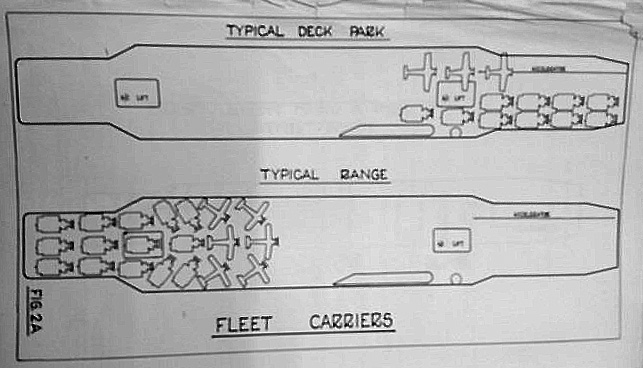
illustrious-aviation-park

hms-victorious-plancut_intern

hms-victorious-plancut_intern

hms-victorious-plancut_intern

hms-victorious-plancut_intern

hms-victorious-plancut_fdeck
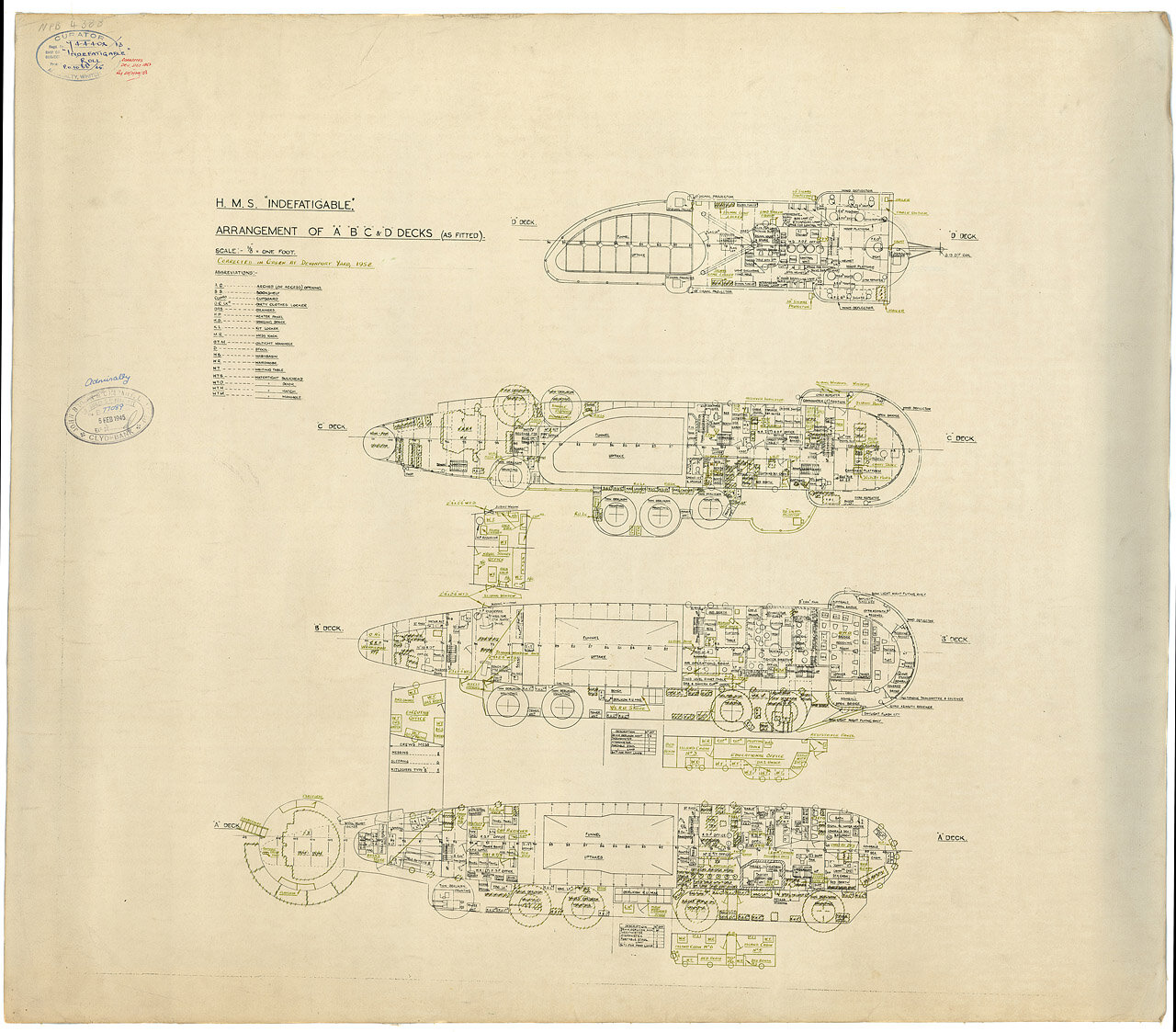
indefetigable-arrangement

hms-indefatigable-BP

Formidable-hangar-lifts-plan

Formidable-deck-intern-plan

Formidable-deck
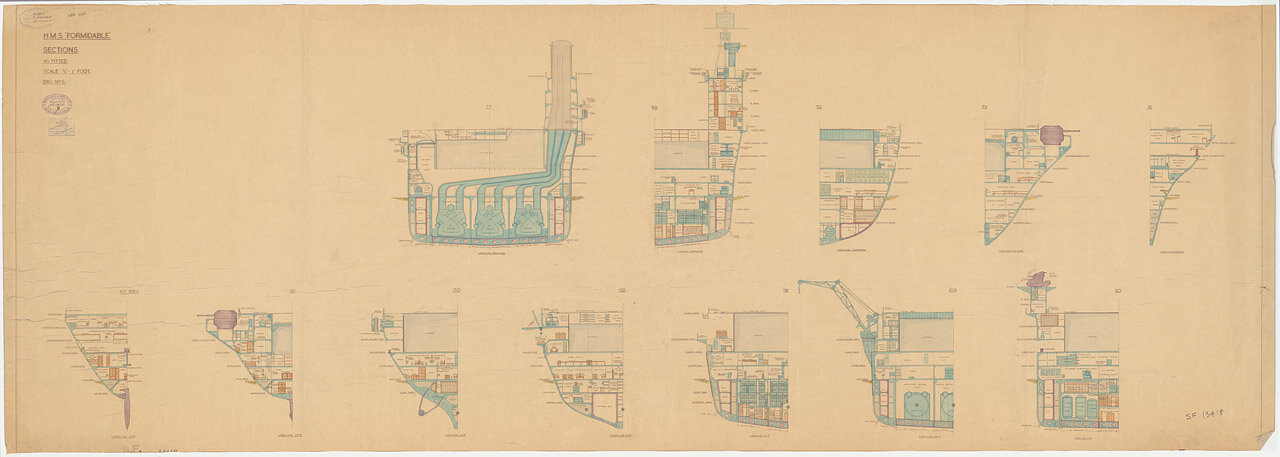
Formidable-cutaways

1938-design-illustrious
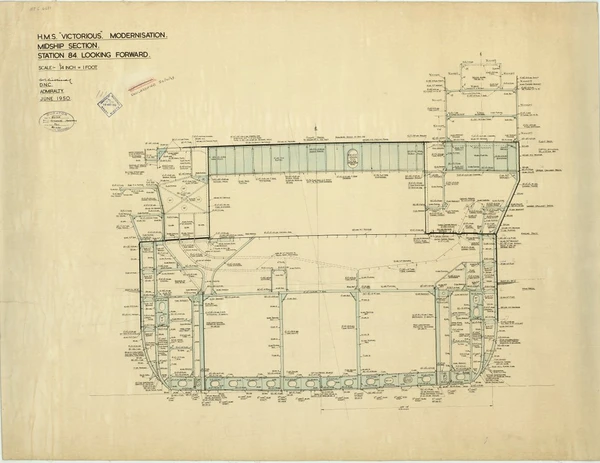
hms-victorious-plancut
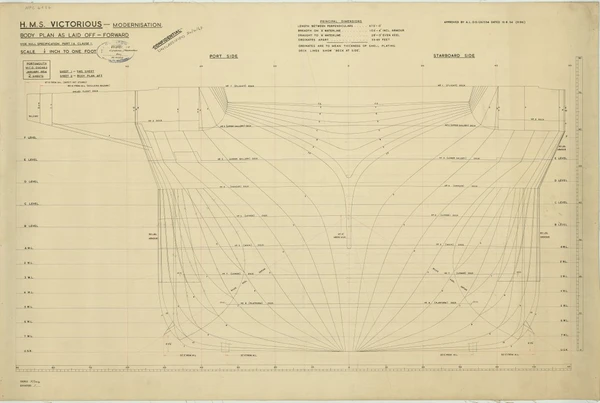
hms-victorious-plancut

hms-formidable-plan

hms-victorious-planprofile

hms-victorious-planprofile
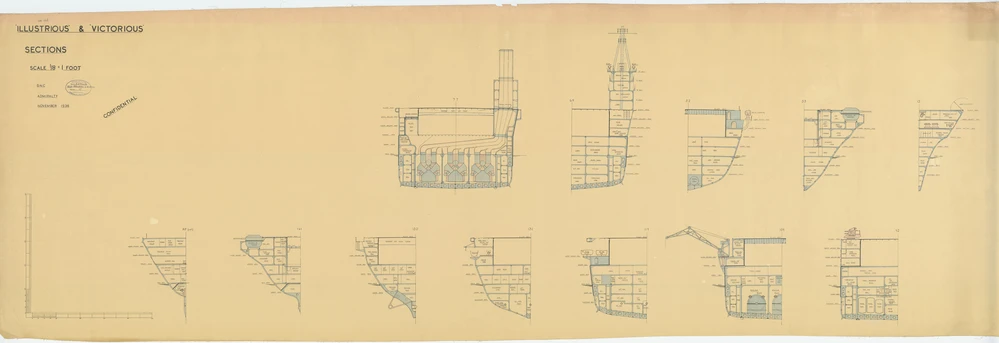
hms-victorious-plancuts

hms-victorious-plancutall
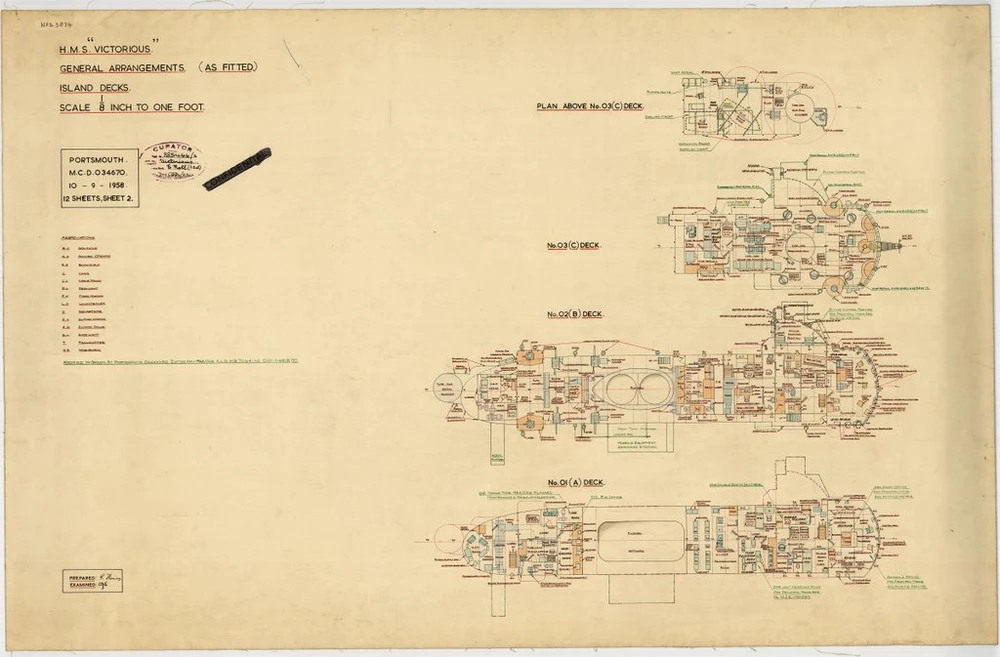
hms-victorious-generalarrangement-cut
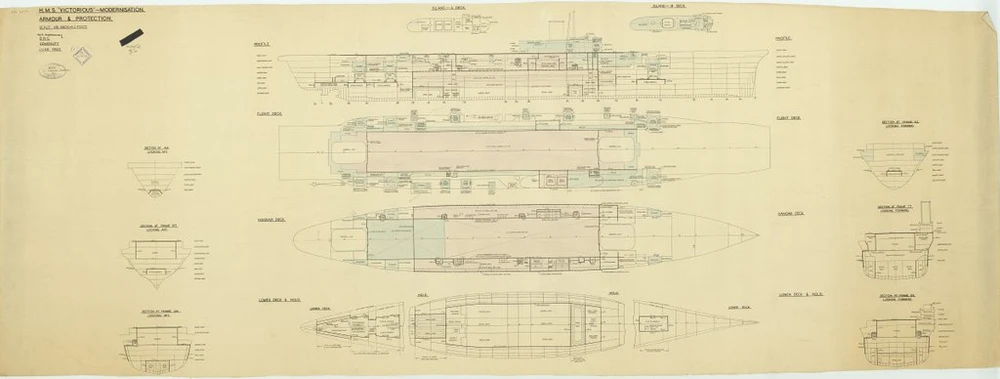
hms-victorious-mod-plan

implacable-plan

implacable-plan1938
Profiles
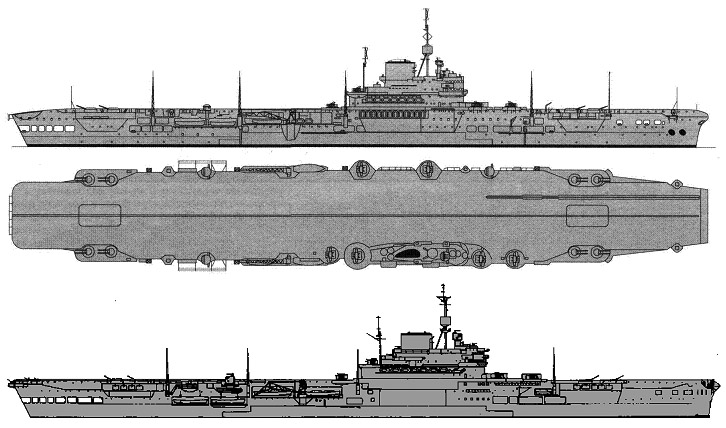
Comparison between Illustrious and Indomitable

Old author’s illustration
HMS Illustrious 1940 specifications |
|
| Dimensions | 205.12 wl/229.58 oa x 29.18 x 8.69 m FL (753 x 95 x 28 ft). |
| Displacement | 23,000 t. standard -28,620 t. FL (29,240 in 1945) |
| Propulsion | 3 shafts Parsons turbines, 6 Admiralty boilers, 111,000 shp. |
| Speed | 30.5 knots (56.5 km/h; 35.1 mph) |
| Range | Oil 4,840 t, Range 10,700 nmi (19,800 km; 12,300 mi) at 10 knots. |
| Armament | 8×2 4.5-in (102 mm/45), 6×8 2-pdr pompom, 33 aircraft. |
| Armor | Belt 4-1/2 in, hangar sides 4-1/2 in, bulkheads 4-1/2 in to 2-1/2 in, flight deck 3 in. |
| Crew | 1229 – 2100 in 1945 |
HMS Indomitable, the fourth sister
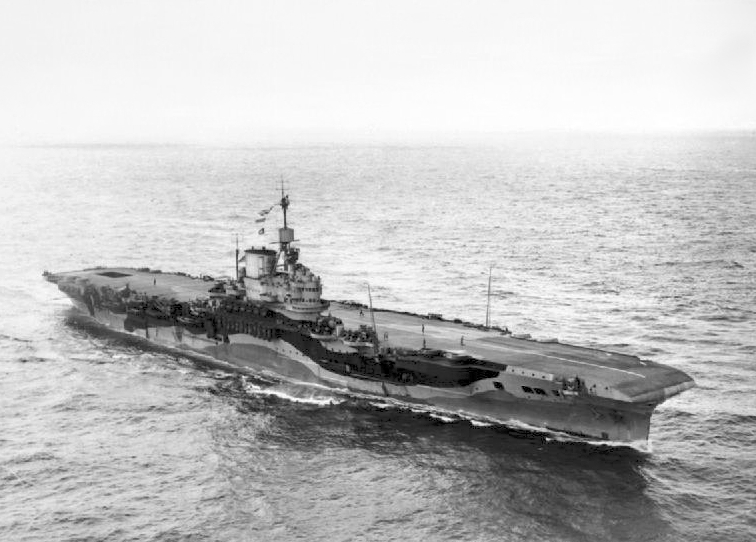
Many authors separate HMS Indmoitable from the rest of the class, making her own class. Conway’s do for example. There are many reasons for this. First off, she was ordered like her sister before the war in 1936, laid down in November at Vickers-Armstrong, but the admiralty, fearful 33 aircraft was bordering to ridiculous for a carrier of such displacement, ordered extensive modifications, also as a test for possible future carriers (which will be the Implacable, laid down in February-November 1939).
The deal was to trade some protection by reducing of 3-in the side armour protection, to accomodate more aircraft. This was not only space gained by this relative decrease, but the hangar was completely revised to accomodate a second one, as the flight deck was raised by 14 feets, leading engineers to watch for the metacentric height. But the armour decrease already did its job. The flight deck effective dimensions became 680 x 95 feets, later lenghtened to 745 feets and squared.
She was slightly longer and displaced a tad more, but for the same beam and draught. The powerplant was unchanged as the general outline, placement of the lifts, arrestor hooks, catapult, general arrangement of the island and armament. However the catapult was more modern and allowed to launch 12.500 – 16.000 Ibs at 66 kts. The new upper hangar measured 458 x 62 x 14 feets (4.26 m), still a tight fit, while the original measured 168 x 68 x 16 feets (4.87 m). The forward lift was larger at 45 x 32 feets, the aft one unchanged. Petrol stowage was somewhat reduced to 75,110 gallons.
There were alterations in the protection as well, outside the walls, the lower gallery deck being 2 to 2-1/2 inches over the magazines and the low deck hangar 1-1/2 inches as well as over the machinery space. When completed in October 1941, so one year after her third sister, she only had three Octuple Bofors, and this was doubled only by April 1942, and buffed in April 1944 by twelve additional Bofors in two quad and two twin mounts. In September 1945, she had 13 Bofors and 36 Oerlikons.
After all this, the operational capacity rose to 56 aircraft, a gain of 23, so two squadrons. Not a small feat, the engineers of the time could be proud of. This made Indomitable the prototype for the revised plans in 1939 of the Implacable class, with kept the same general scheme but on a larger displacement and dimensions. However part of this park was on the deck, and the practical number carried inside was 45 (60 for the Implacable).
HMS Indomitable 1942 specifications |
|
| Dimensions | 209 wl/229.78 oa x 29.18 x 8.84 m FL (753 x 96 x 29 ft). |
| Displacement | 23,200 t. standard -29,730 t. Fully Loaded |
| Propulsion | 3 shafts Parsons turbines, 6 Admiralty boilers, 111,000 shp. |
| Speed | 30.5 knots |
| Range | Oil 4500 t, Range 10,700 nmi (19,800 km; 12,300 mi) at 10 knots. |
| Armament | 8×2 4.5-in (102 mm/45), 6×8 2-pdr pompom, 45 aircraft. |
| Armor | Belt 4-1/2 in, hangar sides 1-1/2 in, bulkheads 1-1/2 in to 3 in, flight deck 3 in. |
| Crew | 1392 – 2100 in 1945 |
The Cold War Illustrious class
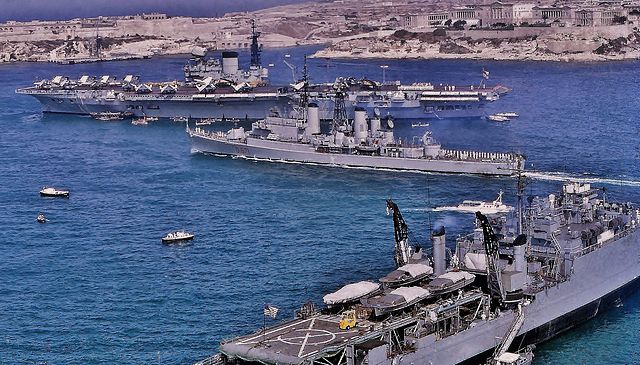
HMS Victorious in Malta, 1967
All three carriers, Illustrious, Formidable and Indomitable, were slightly modernized after the war, but did not served long, until 1957, 1953 and 1955 respectively. Modifications included …
Illustrious and Formidable indeed had suffered the heaviest damage any aircraft carrier would ever sustain in action, and were worn out by 1946. HMS Indomitable, more “spared” than her ealier sister ships, was given an extensive refit in drydock. Cut open, she received new boilers far more efficient, and many other modifications from 1948 to 1950. She became flagship of the Home Fleet and flagship of the the Mediterranean fleet in the 1950s, but suffered a hangar deck petrol explosion and massive fire in early 1953. Placed in reserve after the Queen’s October 1953 Coronation Review it was decided to to repair her so she was scrapped in 1955.
The case of HMS Victorious was different. Arguably the least “battered” of the class, she was estimated in such shape it was found useful to have her completely rebuilt in drydock.
Due to a variety of factors including Britain’s dire post-war finances, and the consequent reductions in the size of the Royal Navy post-war modernization was limited to just the last of the class; Victorious, which was given a massive eight-year-long reconstruction between 1950 and 1957 (to enable her to operate Cold War-era jet aircraft), was retired in 1968 after a minor fire.
Note: Victorious will be the object of a dedicated post, also seeing the other modernized ships of the class.
Links/sources
Books
-Conway’s All the World’s Fighting Ships 1922–1946
-Hone, Friedman, Mandeles, British and American Carrier Development, 1919–1941
-USS Bennington, Action Report, OPERATIONS IN SUPPORT OF THE OCCUPATION OF OKINAWA INCLUDING STRIKE AGAINST KANOYA AIRFIELD, KYUSHU.
-Thomas, Andrew, Royal Navy Aces of World War Two
-Brown, David (1977). WWII Fact Files: Aircraft Carriers. New York: Arco Publishing.
-Brown, David K. (1998). “Re: Armor from Czechoslovakia”. Warship International
-Campbell, John (1985). Naval Weapons of World War II. Annapolis
-Chesneau, Roger (1995). Aircraft Carriers of the World, 1914 to the Present
-Friedman, Norman (1988). British Carrier Aviation: The Evolution of the Ships and Their Aircraft.
-Friedman, Norman (1983). U.S. Aircraft Carriers: An Illustrated Design History.
-Hobbs, David (2013). British Aircraft Carriers: Design, Development and Service Histories.
-McCart, Neil (2000). The Illustrious & Implacable Classes of Aircraft Carrier 1940–1969.
-Rohwer, Jürgen (2005). Chronology of the War at Sea 1939–1945: The Naval History of World War Two
Links
Opsrey New Vanguard British Aircraft Carriers 1939–45
armouredcarriers.com: Illustrious in malta, operation-excess
illustrious-armoured-aircraft-carrier-design
battle-damage-to-hms-illustrious
On www.navyhistory.org.au
On padresteve.com
On navypedia.org
seaforces.org
naval-encyclopedia.com: hms ark royal
On maritimequest.com
On uboat.net
On ww2db.com
wik
Videos
https://youtu.be/H5bTn5dUJ2A
The modeller’s corner

Oriel 1/200, Heller 1/400, JSC 1/400, Airfix 1/600, Aoshima, Flyhawk, Orange Hobby, MT Miniatures, HP Models 1/700, Eaglewall, Pyro 1:1200, Bandai & others 1/2000.
Illustrious on Scalemates
HMS Illustrious 1943 Heller 1/400 – modelshipgallery.com
VICTORIOUS (ANATOMY OF THE SHIP) by Ross Watton

British Aircraft Carriers 1939–45, By Angus Konstam and Tony Bryan
3D view
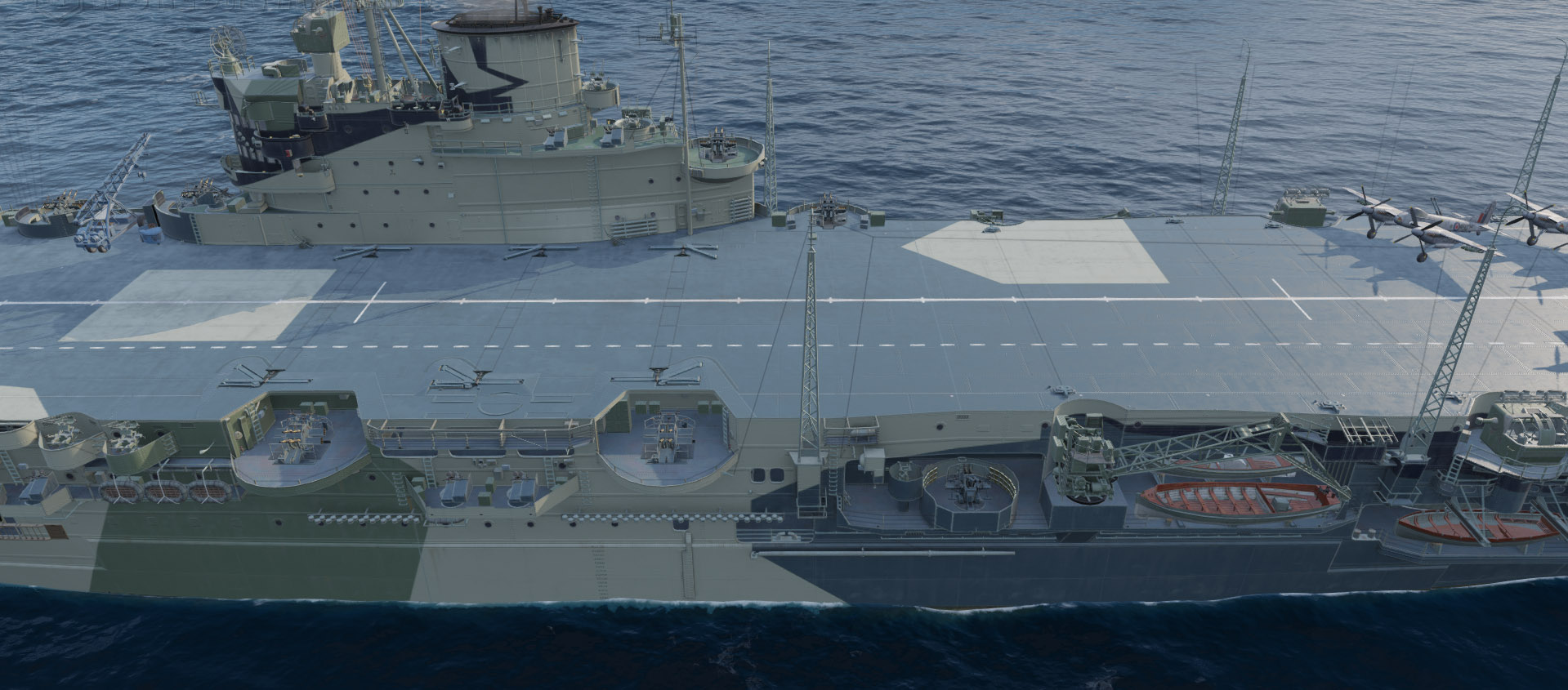
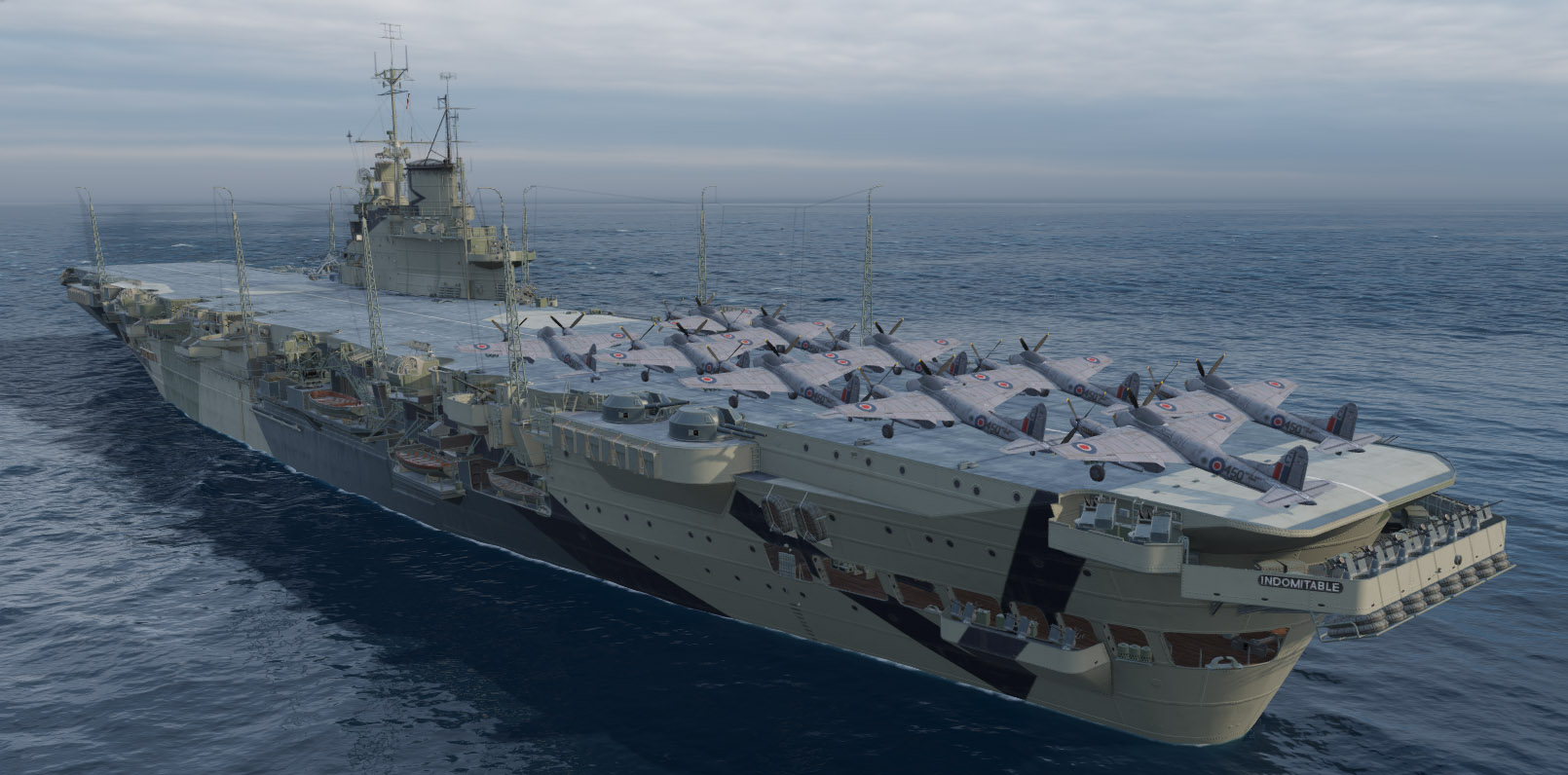
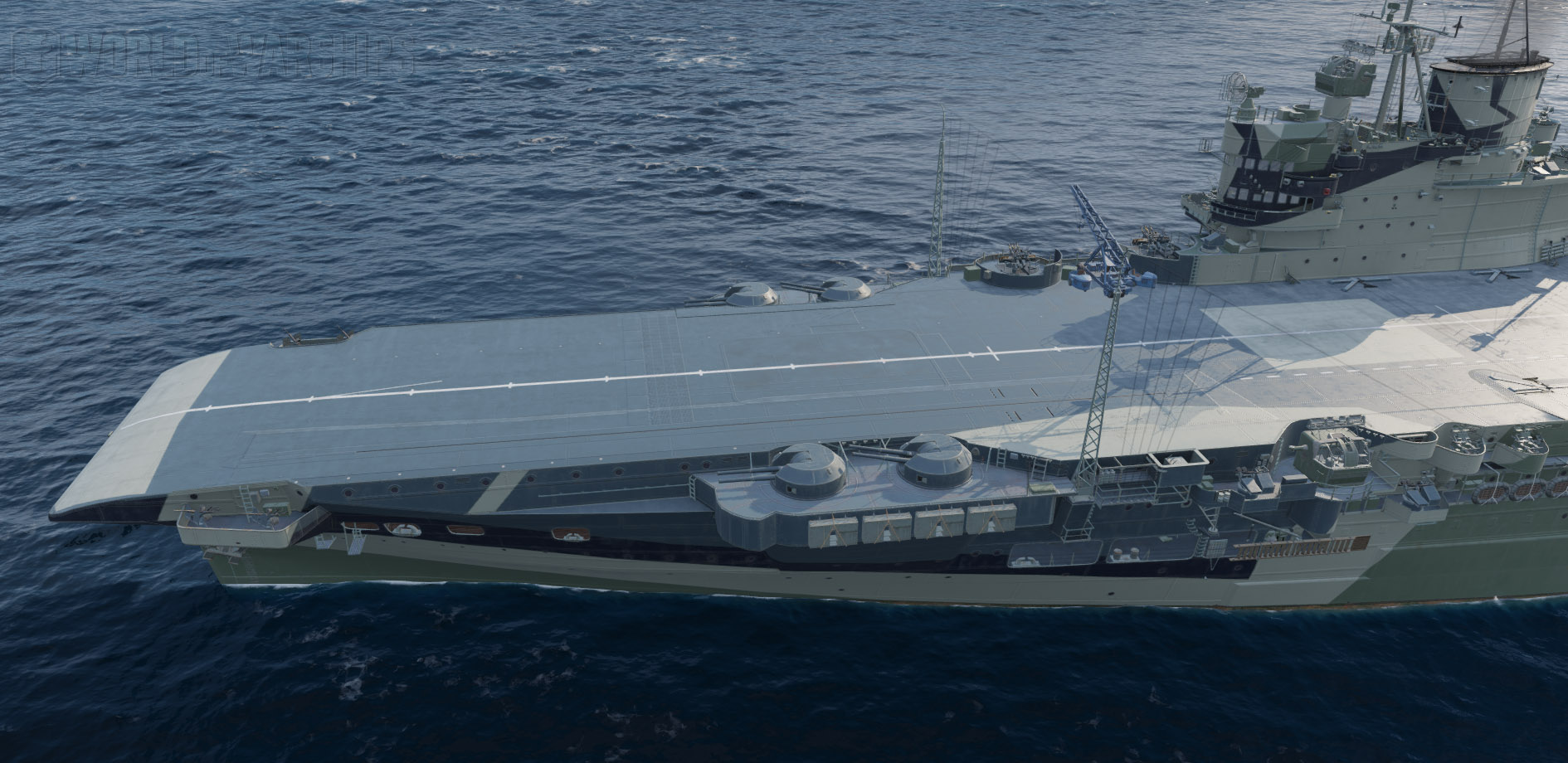

Wow’s rendition of HMS Indomitable
The Ilustrious class in service
HMS Illustrious
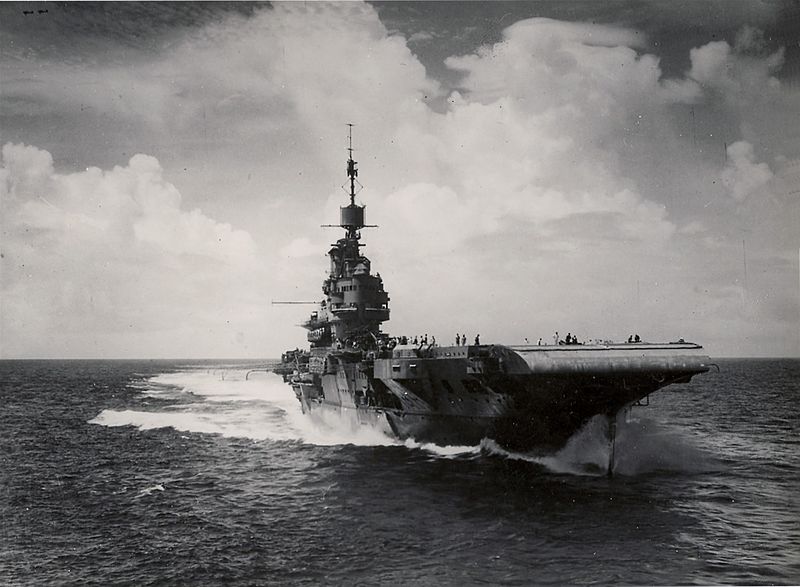
HMS Illustrious in 1944, bow view.
HMS Illustrious was both the 4th ship of her name but the first of the armoured fleet carrier type. Ordered in the the 1936 Naval Programme, the order was awarded to the trusted Vickers-Armstrong, on 13 April 1937. Construction however had to wait for the delivery of her armour plates. This problem also plagued the King Georges V construction, due in large part to the lack of skills as none was delivered after the Washington Naval Treaty. The problem became so acute that the yard was found complelled to order them from the Czech Vítkovice Mining & Iron Corp. Laid down at the Barrow-in-Furness shipyard (N°732), she was launched on 5 April 1939 and towed to Buccleuch Dock for fitting out. Captain Denis Boyd became her first commander, from 29 January 1940, ensuring completion, early machinery trials, until she was commissioned on 16 April. The yard’s bill to British taxpayers was £2,295,000, less actuallu than HMS Ark Royal (over £3 million).
Acceptance trials started on 24 April, delayed as her tugboat, Poolgarth, capsized. Her first airmen trials took place in the Firth of Clyde: Six Fairey Swordfish which inaugurated her deck the day prior (lifted her by cranes). In June, 806, 815, and 819 Squadrons’s personal came onboard at Devonport and 806 Squadron received its Blackburn Skua and Fairey Fulmar. She started advanced training off Plymouth but due to the situation in France with the risk of the Luftwaffe taking off from close by captured airfields, it was decided to evacuate Illustrious to Bermuda, basically to continue working up, which was over by 23 July. Back in the Clyde she flew off her squadrons for operations while undergoing a minor refit, and sailing to Scapa Flow (15 August). There, she became flagship, Rear Admiral Lumley Lyster. Soon with her squadrons back onboard, she sailed for the Mediterranean on the 22th.
Early Mediterranean Campaign
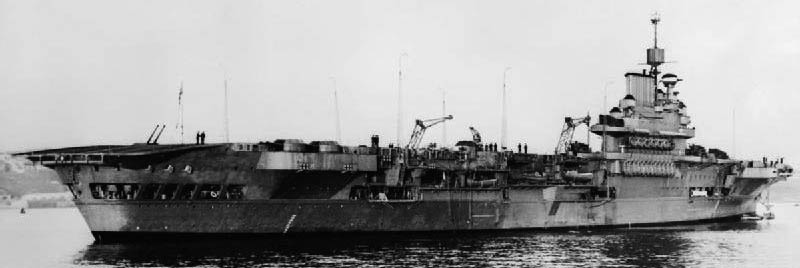
Illustrious in 1940
HMS Illustrious refuelled in Gibraltar, and teamed with HMS Valiant as the centerpiece of Force H, taking part in Operation Hats, her Fulmars shooting down five Italian bombers, her AA two more, and later she deployed eight of her Swordfish with those of HMS Eagle, to attack the Italian seaplane base at Rhodes (3 September). Illustrious later flew a night raid with 15 Swordfish on the 16/17 September on Benghazi. Her 819 Squadron also laid six mines in the harbour entrance, those of 815 Squadron sank the destroyer Borea and two freighters (10,192 GRT).
Aquilone later hit one of the mine, adding to the tally. However when back to Alexandria, she was ambushed by the Italian submarine Corallo, but the latter missed. On 29 September she escorted a convoy to Malta (one of many !) and her Fulmars took off to repel a combined Regia Aeronautoca’s high-level and torpedo bombers. One was downed, but one Fulmar lost. During the return trip, her Swordfish (and Eagle’s) attacked the Leros island airfield by night on 13/14 October.
Another Convoy to Malta
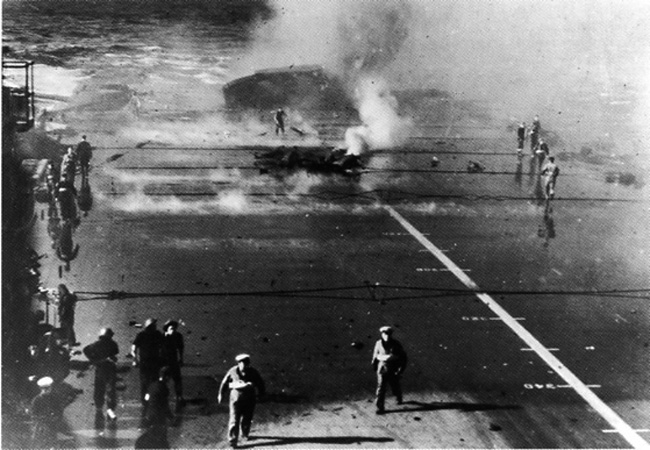
Flight deck hits, 10 January 1941
All these night attacks gave crew enough confidence for even bolder actions. Rear Admiral Lumley Lyster proposed a carrier airstrike on the major Italian naval base in Taranto. In fact this scenario hs been drafted already since the Abyssinia Crisis of 1935. Admiral Andrew Cunningham approved this idea by 22 September 1940 and asked to dra specific plans for a near future action. It was to be led by the two same carriers, Illustrious and Eagle and the schedule was initially set for October 21th, symbolic as the anniversary of Trafalgar.
However a hangar fire broke out on Illustrious three days before and repairs forced delay the action until 11 November: This was the next favourable phase of the moon indeed. The fire was pretty serious and cost three Swordfish, writing off two others, all replaced by spares from HMS Eagle. In addition contaminated fuel tanks had to be cured. Repairs were done at the end of October so that Illustrious escorted a convoy to Greece, her Fulmars claiming CANT Z.506B floatplane.
She sailed from Alexandria on 6 November with Warspite, Malaya, and Valiant plus two light cruisers and 13 destroyers for another convoy to Malta and her air group was full, reinforced by Eagles’s Gloster Sea Gladiators in addition to her 806 Squadron’s Fulmars and Swordfish from 813 and 824 Squadrons in part carried permanently on the deck, which was more handy on the Mediterranean.
On her way, these Fulmars claimed a CANT Z.501 seaplane and later one, perhaps two of seven attacking Savoia-Marchetti SM.79s bombers. On 10 November they short down a A Z.501 searching for the fleet and another the day after. Later they repelled another attack of nine SM.79s, probably claimed one. Three more Fulmars were flown aboard from Ark Royal and both carriers arrived soon at Malta. So at that stage her air group 15 Fulmars, 24 Swordfish, and four Sea Gladiators. Her fuel contamination claimed three Swordfish shortly after take-off on 10-11 November, maintenance making another run around the clock, draining all fuel tanks and refilling them with clean petrol. The following night of the attack therefore, Illustrious still had 21 Swordfish available for the strike of her entire career.
Raid on Taranto
Illustrious was detached from Force H for this raid, escorted by four cruisers, four destroyers. The fleet arrived by night to a point 170 miles (270 km) south-east of Taranto. Soon, the fist wave too off, a dozen aircraft, by 20:40. The second wave took off by 21:34 (nine). Composition was as follows: Six Swordfish had torpedoes and the remainder bombs or flares. This was indeed a 3/moon, ensuring concealment, but the planes needed lighting during the attack. The Royal Air Force also positioned a Short Sunderland off the harbour, looking for activity, using its acoustic locators and alerting the defenders. The noise of the first wave was heard at 22:25 so the anti-aircraft guns prepared. This was not a complete surprise as often stated. Defenses of the port were all ready and Breda guns started to bark as as the first torpedo-carrying aircraft appeared. Two targeted the battleship Conte di Cavour and two the Littorio, two more dropped flares, and two others bombed the oil storage depot. The four bombers targeted a seaplane hangar and hit the destroyer Libeccio but the bomb failed to detonate. Fulmine allegedly also shot down one, but the first wave was back.
For the second wave, one Swordfish was forced back after when its long-range external fuel tank fell off. The others hit Littorio again and Duilio, starting at 23:55. The flare droppers also attacked the oil storage depot and the cruiser Trento was truck by another dud. One torpedo Swordfish was shot down, the rest came back. Another air strike was planned for the following night, but it was cancelled due to bad weather. The R.A.F. later conformed the success of the operation, with three battleships half-sunk. This even comppetely turned the tables and famously served as a confirmation to the Japanese for their own plans. Conte di Cavour was a definitive write-off, Littorio and Duilio were out of action for months and the rest had to flee nortwards, leaving their best operational spot so far.
Illustrious’s Mediterannean Operations
As she sailed to Alexandria Illustrious’s Fulmars claimed three out of four CANT Z.506Bs seaplane bombers on 12 November. Two weeks later the carrier launched a 15 Swordfish-strong raid on Italian positions on Leros (one lost). Off Malta six fighters engaged asix Fiat CR.42 Falco, shooting down one, damaging two others. One Fulmar was damaged but landed and was repaired; On the night of 16/17 December, 11 Swordfish raided Rhodes and Stampalia. Four days later two convoys off the Kerkennah Islands were attacked and two merchant vessels sunk (7,437 GRT). On the morning of 22 December 13 Swordfish raided Tripoli, setting the depots and warehouses ablaze. Illustrious at last anchored in Alexandria to resupply. There was plenty of action to come.
Operations excess (Malta convoys)
On 7 January 1941, Illustrious was underway to provide air cover for another set of convoys to Piraeus in Greece, but also Malta: Operation Excess. She received on board three Fulmars from 805 Squadron and on 10 January her Swordfish took off and attacked an Italian convoy previously spotted, but without result. Three of her CAP (defensive patrol) engaged three SM.79s, claiming one. One Fulmar was damaged and the others camed back, short of ammunition and fue. They landed at Malta’s Hal Far airfield. The remaining two engaged two more incoming SM.79s, one shot down, the other repelled, damaged. They too had to land where they could after chasing the Italians over 50 miles (80 km). Four replacements took off the same day at 12:35, right in time to intercept 24–36 Junkers Ju 87 Stuka of Ist Gruppe/Sturzkampfgeschwader and II. Gruppe/StG 2. Led by veteran Paul-Werner Hozzel they attacked in turn with 250/500 kgs (550 or 1,100 lb) bombs. One struck forward of the aft lift where one lifting Fulmar was stuck, burning.
A Fulmar took off and engaged the Stukas, but Illustrious was soon overwhelmed and hit five more times: One bomb struck the un-armoured aft lift, detonated beneath, destroyed. Another destroyd the starboard forward “pom-pom” mount clsoe to the island. Another passed through the forwardmost port AA mount, failed to detonate. One more penetrated the outer edge of the forward port flight deck. It detonated 10 feet (3.0 m) above the water. The hull structure was poked off, causing flooding while a third fire broke out. The most damaging hit however was probably a one-ton ordnance penetratring through the deck armour, forward of the aft lift. It detonated 10 feet above the hangar deck. A new, more severe fire started.
The rear fire sprinkler system was destroyed, and fire curtains became splinters, cutting down everything in their path. It blew a hole in the hangar deck. The damage went down three decks below.The carrier also took two near-misses causing minor damage and flooding. But the concussion of the multiple aft hits damaging Illustrious’s steering gear.

Battle damage at Malta, HMS Illustrious
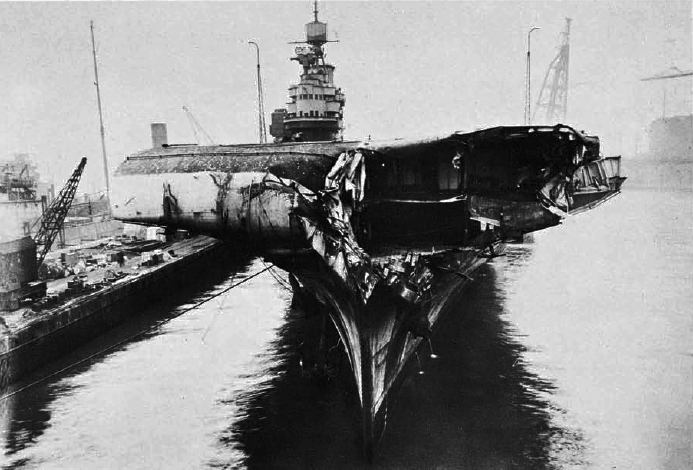
Illustrious’s bow damage
This was not the end of Illustrious’s pains though. Another attack by 13 Ju 87s started at 13:20. One bomb hit the aft lift well again, definitely knocked out her steering gear for good. Her speed fell to 15 knots. Six Fulmars were in the air, but they had to be rearmed and refuelled ashore. Two Stukas were damaged before the Fulmars ran out of ammunition. Illustrious was still steered by using her engines and was underway when attacked several more times before making it into Malta’s Grand Harbour at 21:04. She was still bruning at that point, having 126 officers and men dead, 91 wounded, with nine Swordfish five Fulmars destroyed. Help came from Malta and five Ju 87s were shot down, plus three by the combined AA.
Malta’s Blitz
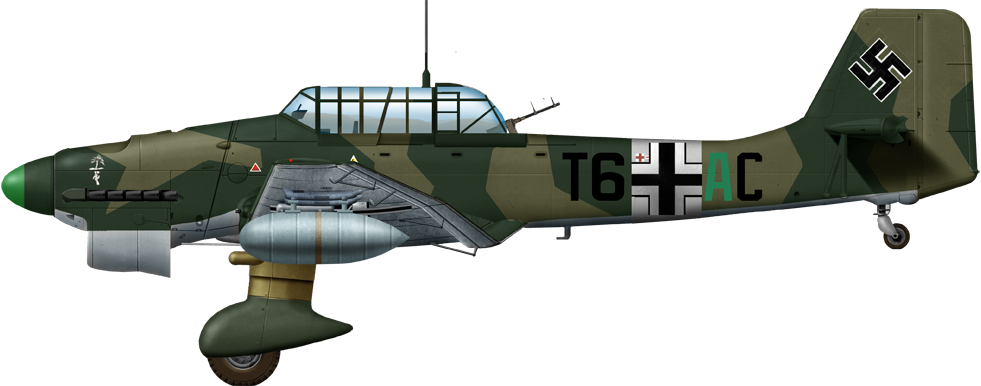
Ju 87 Stuka, StG1 over Malta, 1941
Her steering was repaired in Malta but she was not safe, as more waves came to finish her off, starting on 16 January (17 Junkers Ju 88, 44 Stukas). 806 Squadron’s claimed two, damaged two. But the carrier took a 500 kg bomb hit, which penetrated her flight deck, aft of the rear lift. It wrecked the captain’s day cabin. She also had several near-misses. Only one Fulmar was left on 19 January, shot down during subsequent attacks. She was near-missed several time, shock waves dislodging hull plating, so much she flooded and took a 5° list while her port turbine basis was cracked open, her whole machinery taking damage. Naval historian J. D. Brown noted the soundness of her armoured hangar saved her as no other carrier could have taken such punishment and survive. Having expaneded all her onboard aviation as soon as she was out of the drydoc, Illustrious was back at sea, reaching Alexandria on 23 January, escorted by four destroyers. She entered the drydoc for more temporary repairs, until 10 March whereas as a flagship, she hosted Boyd that relieved Lyster, soon transferring his flag to HMS Formidable before Illustrious left Port Said. Instead of crossing the Mediterranean, she went south, transited the Suez Canal after mines laid down by the Germans were cleared off, and so she only resumed her trip on 20 March, heading for for Durban in South Africa. There, the large drydock could accomodate her in good conditions. Underwater damage was assessed and repaires started for two weeks, enough to depart again due east, to the US coast and Norfolk Navy Yard drydock for full repairs, starting on 12 May.
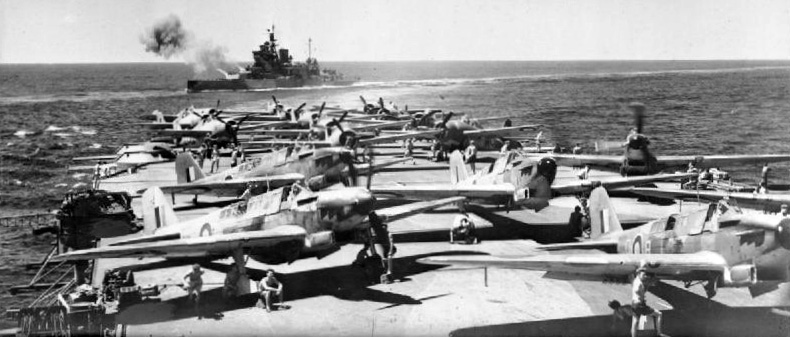
HMS Valiant fires her guns in exercizes, seen from Illustrious in 1942
Repairs and Training
Modifications were made during this long overhault, notably her flight deck arrangements and shape was reviewed, she received a new aft lift, US-standard catapult, more light AA armament and other modifications. Captain Lord Louis Mountbatten became her new captain on 12 August, sent on a speaking tour in the US (at the time, the US were still not at war). In October Mountbatten was relieved by Captain A. G. Talbot and the refit was completed in November 1941. She departed on 25 October for post-refit trials off Jamaica. Later she met a ship carrying her load of 12 Swordfish (making the 810 and 829 Squadrons). Back in Norfolk on 9 December she met with HMS Formidable repaired there too. Both sailed for home but in the 15/16 December night, HMS Illustrious collided with HMS Formidable in a moderate storm. She entered Greenock on 21 December for post-storm repairs. In late February 1942 she left Cammell Laird to train her new air group in March, receiving also two squadrons (881n 882 Sqn) of Grumman Martlet fighters and also tested the first Navalized Supermarine Spitfire, leading to the development of the Seafire.
Indian Ocean Campaign
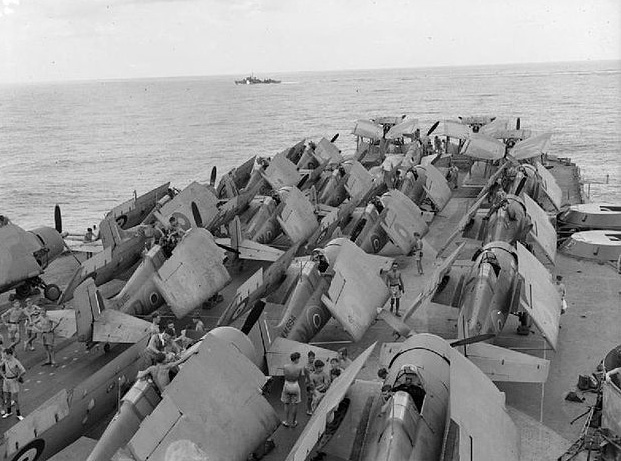
Indian Ocean Campaign
Operation Ironclad, 3 May 1942

Indian Ocean Campaign
Operation Ironclad, 3 May 1942
The conquest of British Malaya and the Dutch East Indies by the Japanese in early 1942 enable access to the Indian Ocean. At the time, Madagascar Island was stuck in the line of communication between India and Great Britain. The odd French position towards the axis meant it was likely, like in Indochina, to cede to Germany’s allies, the Japanese here as well. To foil any Japanese occupation plan, the Chuchill instructed Cunningham to prepare an invasion. An attack on Diego Suarez, the main port, arsenal and nava base of Madasgascar was scheduled for May 1942.
HMS Illustrious saw her refit stopped ad she was assigned on 19 March to the Eastern Fleet. She sailed with twenty-one Swordfish, nine Martlet mark II (881 Sqn), six Martlet Mk.I (882 Sqn), two Fulmar as fighters. She also escorted a troop convoy for the assault. However there was a serious hangar fire on 2 April. 11 aircraft were gone, one killed, but damage was moderate overall and she was repaired in Freetown (Sierra Leone), receiving twelve additional Martlet II from HMS Archer traded for the Mark Is. So between the hangar and deck she carried 47 planes. She sailed to Durban and her crew also fitted and made operational her intended ASV radar.
Upon arrival her air group, remembering Dakar and the coarse reaction of the Vichy French to any allied attack, French naval units and shipping were to be sunk on sight. HMS Indomitable meanwhile provided air support for the ground forces during the invasion. 25 Martlets were in the air, completed by one Fulmar patrolling at night, and 21 Swordfish which roamed the port in search of targets.
On 5 May at dawn, 18 Swordfish escorted by 8 Martlets took off and the first batch attacked, but missed the colonial sloop D’Entrecasteaux. They sank the armed merchant cruiser MS Bougainville. The second wave had depth charges and dropped them on the submarine Bévéziers that was trying to sail out and attack when caught.
A third wave dropped leaflets and then attacked an artillery battery. They also tried to sink D’Entrecasteaux but missed. The following day, the French sloop tried to leave the port but was caught and bombed by a single 829 Squadron Swordfish. Her captain had her running aground not to sink. Martlets (881 Sqn) shoot down two Potez 63.11 bombers and dropped dummy parachutists as a diversion (a technique later used in Normandy).
A patrolling Swordfish with DCs spotted and sank the submarine Le Héros while other targeted French defences when spotted. On 7 May, Martlets shot down three Morane-Saulnier M.S.406 incoming, but one Martlet was damaged. The single Fulmar was also shot down by AA. In all, her air group combined 209 sorties. There were six deck landing crashes, notably by four Martlets. The proper invasion took place, and she left Magalasi waters, mission accomplished.
Eastern fleet service
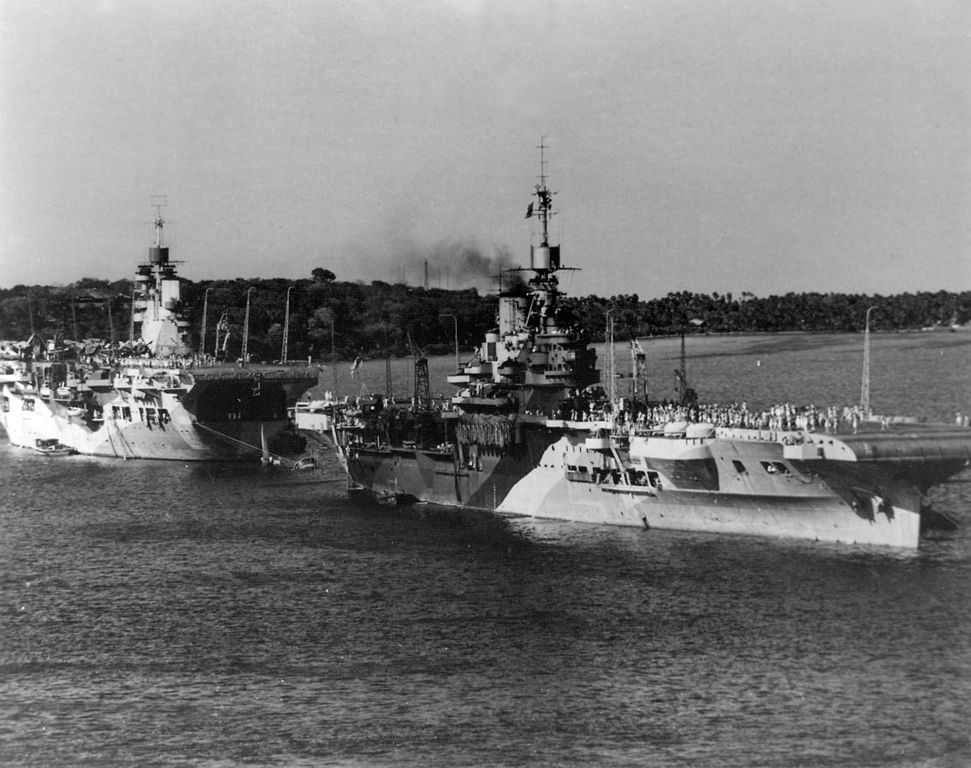
HMS Unicorn and Illustrious in Trincomanlee, 1944
Assigned to the Eastern Fleet now formally, Illustrious headed to Durban, and sailed to Colombo (Ceylon) as flagship for Denis Boyd (her former captain) as Rear Admiral, Aircraft Carriers, Eastern Fleet. In August, she took part in Operation Stab, a decoy invasion of the Andaman Islands while the main assault on Guadalcanal took place. Captain Robert Cunliffe took command on 22 August and on 10 September she covered Operation Streamline Jane, the second landing of Madagascar, and a landing of nearby Tamatave, deploying an air group 6 Fulmars (806 Sqn), 23 Martlets (881 Sqn), 18 Swordfish (810, 829 Sqn). She was visited by the Eastern Fleet commander, Admiral Sir James Somerville on 12 January 1943 and sailed for home. Her air group underway landed in Gibraltar (31 January) and she arrived in the Clyde. The battered carrier entered a more quiet career, hosting the prototypes of the Blackburn Firebrand and Fairey Firefly, Fairey Barracuda, tested from 8 to 10 February. On 26 February she started a refit at Birkenhead until 7 June: Flight deck extended, new radars, buffed up AA, two new arrestor wires. Meanwhile Martlet Vs and Barracudas trained hard. Post-refit trials were over on 18 July and she was recommissioned.
Atlantic Operations (July 1943)
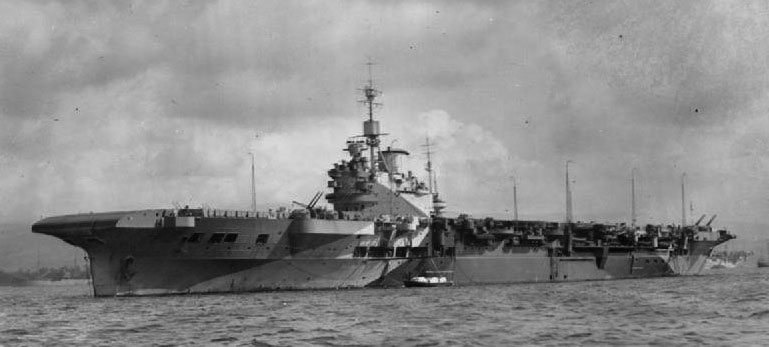
HMS Illustrious in 1943
On 26 July 1943, she took part in Operation Governor in Norwegian waters escorted by the brand new battleship HMS Anson but also the new battleship USS Alabama and the fleet carrier HMS Unicorn. This was a decoy operation to have the Germans looking away from Sicily, the main objective. 810 Sqn was re-equipped with Barracudas and she had in complement the 878 and 890 Fighter Squadrons (10 Martlet Vs each) plus for the first time, 894 Squadron equipped with 10 Seafire Mark IICs, parked on the deck as they missed folding wings. Blohm & Voss BV 138 flying boats spiotted them, promptly shot down by 890 Sqn. The fleet was back to Scapa Flow on 29 July, transferred to Greenock and on 5 August, Illustrious covered the ocean liner RMS Queen Mary with PM Winston Churchill en route for the Quebec Conference. The Illustrious left the convoy for Greenock, but was soon prepared to sail again for the Mediterranean.
Back to the Med (August-September 1943)
With HMS Unicorn, she departed on 13 August, heading towards Malta. Her objective was to cover Operation Avalanche, the Salerno landings. She took on board four more Martlets and sailed with Force H with a protection duty against any sortie of the Regia Marina, but also as ground support. There was no resistance. Seafires were soon prone to accidents and after being sent back to HMS Unicorn, they flew ashore for air cover until back to Illustrious on 14 September, then refilling in Malta. Illustrious then headed home, Birkenhead for more modifications of her flight deck, plus additional AA. She carried new Barracudas (810 and 847 Sqn), arrving on 27 November. She was also assigned Vought Corsairs from 1830 and 1833 Squadrons, still training, which flew onboard on 27 December 1943. However the Mediterranean at that stage was almost an allied lake, and she was more needed in the east, when the fight was still fierce.
Back to the Indian Ocean (1944)
Operation Cockpit & aftermath (1944)
Operation Cockpit & aftermath (1944)
Illustrious depated on 30 December for Trincomalee (Ceylon), arriving on 28 January 1944. She trained there but made sorties with the Eastern Fleet, trying to spot Japanese warships in the Bay of Bengal or Sumatra. On 21 March she met USS Saratoga for a combined attack on Japanese facilities in the Dutch East Indies and Andaman Islands. The naval base at Sabang (Operation Cockpit) was devastated. Oil storage tanks were destroyed, port facilities wrecked. The Barracudas shown very capable in these operations. Fighter claimed 24 aircraft on the ground as well. While Saratoga departed for home (refit) on 19 May, Somerville planned another strike with Illustrious, targeting the naval base and oil refinery at Surabaya in Java, which was Operation Transom. Illustrious refuelled at Exmouth Gulf (western coast of Australia) but attacked the south and across Java. Barracudas lacked the range and 18 Grumman Avengers (832, 845 Sqns) replaced them for that mission. The first 18 took of on 17 May escorted by 16 Corsairs. One crashed, one was shot down over the target, but almost nothing was seen. A small ship was sunk, but the refinery was damaged.
On 10 June, Illustrious simulated another airstrike on Sabang while strikes would be made in the Mariana Islands, with Saipan as main objective. An attack on Port Blair (Andaman Islands) was planned nevertheless for mid-June. She received 14 more Corsairs of 1837 Squadron and six Barracudas (No.21 TBR Wing). On 21 June, 15 Barracudas and 23 Corsairs raided Port Blair but bad weather degraded accuracy and damage was light but a few small craft, planes on the ground and installation. She was back in Trincomalee on 23 June.
Operation Crimson (July 1944)
With HMS Indomitable and Victorious and her new Captain Charles Lambe she was asked by Somerville to attack Sabang again Operation Crimson. Barracudas were deployed for anti-submarine patrols. On 25 July, Illustrious launched her 22 Corsairs for the procetive CAP. Two small freighters were sunk, the oil storage and port facilities were wrecked. One Corsair was shot down by AA and in the end, another shot down the sole Nakajima Ki-43 “Oscar” and Mitsubishi Ki-21 “Sally” in the air for reconnaissance. An incoming flight of ten Ki-43s was intercepted and decimated. Back in Trincomalee, her 1837 Squadron was transferred to the Victorious.
On 30 July 1944, she departed for a refit in Durban, until 10 October, and she was back in Trincomalee on 1 November. For six weeks she trained hard for the next planned operations with other carriers and on 22 November, was assigned the British Pacific Fleet of Admiral Sir Bruce Fraser, specifically the 1st Aircraft Carrier Squadron (Rear Admiral Sir Philip Vian) in Colombo. Illustrious and Indomitable raided an oil refinery at Pangkalan Brandan (Sumatra), called Operation Outflank with 36 Corsairs and 21 Avengers. But accuracy was so poor on 20 December, they attacked Belawan Deli instead, also partially obscured. This was monsoon season and there was moderate success.
Illustrious’s Pacific Campaign (1945)
Operation Meridian (January 1945)
Operation Meridian (January 1945)
On 16 January 1945, the Britush Pacific Fleet (BPF) headed for Sydney and prepared for the next operations. Underway, the air groups attacked Palembang (24-29 January) in Operation Meridian. Illustrious deployed 32 Corsairs and 21 Avengers, her attack destroying the oil tanks and wrecking the refinery. It was repaired after three months. Another refinery was hit later, but the air group lost five Corsairs and three Avengers (AA and fighters), for four aircraft shot down, including a Nakajima Ki-44 “Tojo” by an Avenger. During an attack of seven Japanese bombers all were shot down, but AA shells landed on HMS Illustrious, killing 12 and wounding 21, a tragic “blue on blue” that was not uncommon at the time.
Operations with TF 57 (March-April 1945)
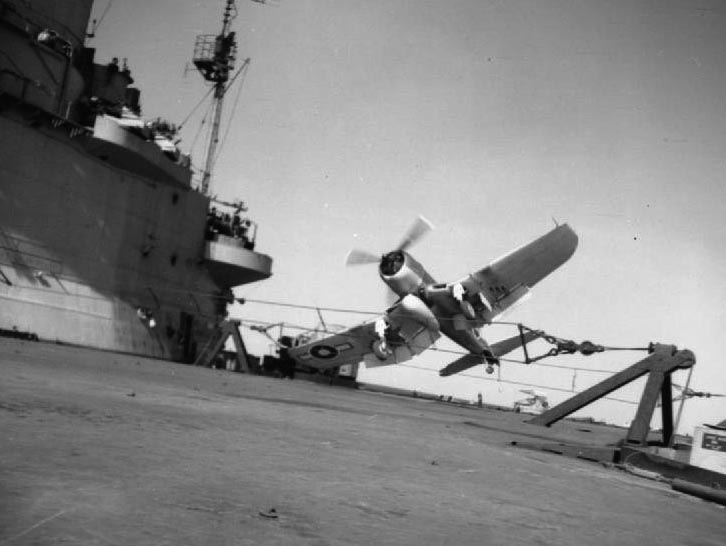
A Corsair Mk.I shot when crash landing, during the campaign on Formosa, March-April 1945
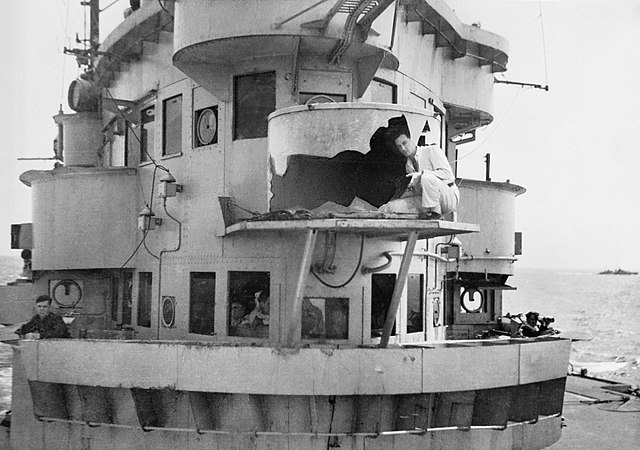
Kamikaze Battle Damage
On 10 February, repairs started in the Captain Cook Dock, Garden Island NyD in Austrlia. Vibration problems with her centre propeller shaft were now out of control and the propeller was removed, the shaft locked and top speed capped to 24 knots. On 6 March she was at sea again with the BPF and sailed to Manus Island to join HMS Indomitable, Victorious, and Indefatigable. The four sisters started common exercises before departing for Ulithi on 18 March, US 5th Fleet where they were renamed Task Force 57. They took their share of Operation Iceberg, the invasion of Okinawa. Their role was double, destroying airfields on the Sakishima Islands (Okinawa-Formosa) from 26 March, and they flew an extended park of 36 Corsairs (armed with rockets and bombs) and 16 Avengers, plus two Supermarine Walrus flying boats deployed in SAR missions for planes shot down.
From 26 March to 9 April on 2-4 days of flying operations followed by 2-3 days of replenishment. On 27 March, 854 Sqn. commanding officer ditched his Avenger and was rescued by an American submarine. On 6 April, four kamikaze went through the defences and a sole Yokosuka D4Y3 “Judy” made a dive on HMS Illustrious, dealt for by light AA enough so that it deviated, damaged and went crashing nearby, port, but it hit the Type 272’s radome of the bridge while its one ton (2,200 lb) bomb near-missed just 50 feet (15.2 m). The blast damaged two Corsairs parked nearby, and shook the ship and vibrations worsened, with damage to the hull structure and plating. TF 57′ Vice Admiral Sir Bernard Rawlings ordered HMS Formidable to replace Illustrious on 8 April (as she was underway) so that she could sail out for repairs, but Illustrious continued operations on northern Formosa until the 14th. She recorded 234 offensive and 209 defensive sorties, claiming two kills, with two Avengers and three Corsairs lost in action.
HMS Formidable replaced Illustrious which sailed to Philippines San Pedro Bay for a detailed damage inspection, starting on 16 April. Divers revealed her outer plating was split, with transverse frames cracked. Emergency repairs were done so she could sail to Sydney. TF 57 arrived in San Pedro Bay herself on 23 April for a long replenishment pand rest, allowing Illustrious to transfer her aircraft but also spares, stores, and pilots before heading to Sydney on 3 May 1945, arriving there on 14 May.
After more torough repairs, she sailed 10 days later for Rosyth while 854 Squadron was landed in Sydney, but she went home for her own defence with two Corsair squadrons. She arrived home on 27 June 1945, and entered drydock while her crew get some well deserver rest.
On 31 July Captain W. D. Stephens took command but in August, before her refit would take place, rushed for final operations, the admiralty decided to keep her home for training and trials carrier. Her catapult was upgraded for a second time to handle heavier aircraft, the flight deck improved, radars modernized, and she was properly repaired, making her post-refit trials on 24 June 1946. The rest is her cold war career, and this will be seen in a separate post.
HMS Formidable
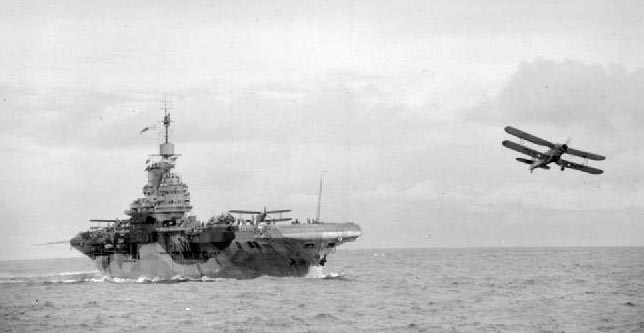
On 17 August 1939 she became the “ship that launched herself”, as a wooden cradle supporting her collapsed, two days before the official ceremony. She slid down the slipway with workmen still underneath and around, a spectator was killed by flying debris along the way and 20 others were injured, but the ship was was not damaged. After her first captain took command for the fitting up and final preparations, sea trials, she was commissioned on 24 November 1940, more than a week after the exploit of her sister Illustrious over Taranto.
During her training, she received her complements of Fairey Albacore torpedo bombers (826, 829 Sqns) and Fairey Fulmar (803 Sqn) while in Scapa Flow on 12 December 1940. She sortied as a convoy escort with HMS Dorsetshire and Norfolk on 18 December while looking for KMS Admiral Scheer, preying on Convoy HX 84. Failing to locate her, they escorted another convoy to Cape Town in South Africa, arriving on 22 January 1941. Formidable then replaced HMS Illustrious in the Mediterranean Fleet after she was badly damaged. Underway nortwards, she launched airstrikes on Italian Somaliland and Eritrea, sinking the 5,723 GRT steamer Moncalieri on 12 February. The Italian AA claimed however two Albacores.
Battle of Cape Matapan
Proceeding to the recently mined Suez Canal she reached Alexandria on 10 March. She received for her 829 Squadron Fairey Swordfish replacing losses and on 20 March escorted a convoy to Malta while launching her air group to Crete before going back. On 27 March, the Italian Fleet was spotted between Egypt and Greece. Formidable was ordered to sail out in the afternoon escorted by three battleships, cruisers and destroyers (under Cunningham command) in interception. By that time her air group was an all-time low with only 13 Fulmars, 10 Albacores and 4 Swordfish (so 26 planes, far less than her normal capacity). She launched her Albacores at dawn next day, one locating the leading Italian ships.
Right away she launched six Albacores loaded with torpedoes. They soon reached and attacked Vittorio Veneto, their escorting Fulmars repellig two escorting Junkers Ju 88. The attack failed. Another strike force (three Albacores, two Swordfish) was launched at 12:22. Meanwhile Formidable was attacked herself by two Savoia-Marchetti SM.79 bombers equipped with torpedoes, but missed and were driven off by AA and the CAP. At 14:50, one Albacore scored a hit on Veneto which knocked out her engines, caused heavy flooding. Soon six Albacores and two Swordfish were prepared and launched at 17:30 to finish her off. They however found instead Pola in the dark and attacked her, scoring a hit (possibly a Swordfish from 815 Squadron, Maleme in Crete).
This error allowed Veneto to make it home, but the two other heavy cruisers were dispatched to assist Zara and the battleships closed in with radar, blating them and giving Cunningham a stunning victory. One Albacore was shot down by Vittorio Veneto”s AA two others later ditch at sea, running out of fuel. HMS Formidable was third in line behind Warspite and Valiant, ahead of Barham when the battleships famously open fire, and she joined them with her own 4.5-inch guns, although she was ordered to step back. She scored at least one 4.5-inch hit, making the sole occasion of such engagement in WW2.
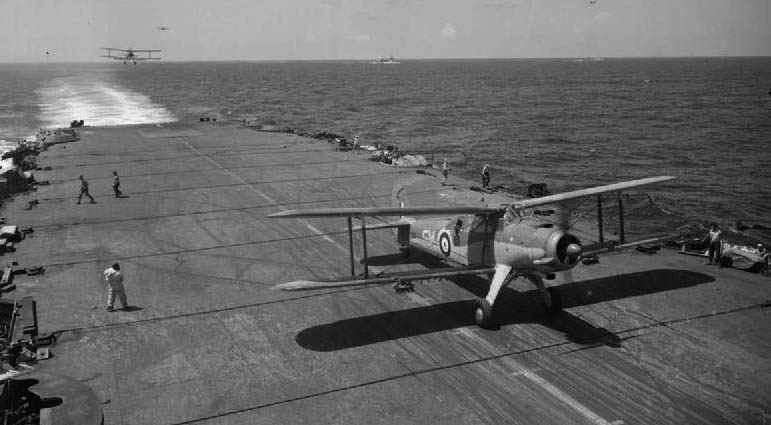
Albacore onboard HMS Formidable, 1943
Greece and Malta (April-December 1941)
On 18 April, the British Mediterranean Fleet departed to shell Tripoli. En route, the fleet was attacked by two torpedo-carrying SM.79s, coming from Rhodes. Fulmars drove them out, but one damage, crash-landed aboard Formidable later. 806 Squadron Fulmars shot down a CANT Z.1007 from Cyrenica and two Junkers Ju 52 transports later. On 21 April, the fleet was facing the port and her aircraft dropped flares to illuminate the port. On the way home, two Fulmars shot down a Dornier Do 24 flying boat.
In the north the situation degraded: The Evacuation of Greece saw HMS Formidable provided air cover for the troop Convoy GA-15, on 29 April 1942. She lost a Fulmar (803 Sqn) was forced to ditch on 2 May. Back in Alexandria she refilled and sailed out again on 6 May to participate in Operation Tiger. On 8 May, two Fulmars allegedly shot down two Z.1007s but one failed to return.
They shot down later four German Heinkel He 111 bombers, one Fulmar was damaged and crash-landed. Two Albacores and a Fulmar also crash-landed. A Ju 88 reconnaissance bomber was also badly damaged the following day and crash landed in Sicily. The Tiger convoy was closed to Alexandria on 11 May when a formation of Ju 88s came to attack. With just two Fulmars to intercept them, they only damaged one, one Fulmar and a Ju 88 were lost. But if the German attack failed, the remaining Fulmars were all in repairs and HMS Formidable had no air cover left.
On 26 May, she was out at sea for a dawn raid on Scarpanto, planned for dawn. She had 12 Fulmars (mostly serviceable), 15 Albacores and Swordfish. Six Albacores and four Fulmars attacked the airbase. One Ju 88 destroyed and two others damaged, plus a SM.81 transport plane, six Fiat CR.42 Falco. Underway back to Egypt, her Fulmars shot down a He 111, two Ju 88s, but lost one Fulmar, crash-landing on the carrier, another ditched out. Around 13:10 Junkers Ju 87 Stuka (II./StG 2 based in Cyrenica) attaced the formation. They soon went through the CAP and hit HMS Formidable with two 1,000-kilogram bombs. This also blew the escorting destroyer Nubian’s bow off. One bomb passed completely through the outer starboard forward flight deck, but she detonated above the water and crippled her side. A close near miss blew a large hole on her starboard side, but underwater, which cause some flooding. In all, she had 12 killed, 10 wounded 10. One Stukas was shot down, but the badly damaged flight deck was unable to recover the planed until repaired around 18:00.
HMS Formidable arrived at Alexandria, disembarked her air group and received emergency repairs. She sailed out on 24 July for Norfolk Naval Shipyard. She only had 829 Squadron (Albacores) onboard for ASW patrols along the way. She arrived on 25 August 1941, repairs were complete in early December 1941. After sea trials, she sailed for Britain with HMS Illustrious, also repaired there, on 12 December but she later coliding with her sister ship (15/16 December night) with little damage. Repairs took place in Belfast until 3 February 1942. She soon received Albacores of 818 and 820 Sqns plus welcomed fighters, Grumman Martlet of 888 Squadron.
Indian Ocean Operations (Feb-May 1942)
HMS Formidable was at sea on 17 February bound for the Eastern Fleet, Indian Ocean wile escorting a convoy to Freetown (Sierra Leone). She also carried onboard Admiral Sir James Somerville, soon to be Commander-in-Chief. In Colombo on 26 March the Japanese First Air Fleet was spotted departing from Celebes to attack them and Somerville was informed of an attack on Ceylon on 28 March but ordered his fleet to assemble southeast on 30 March for an interception (Force A, Formidable, Indomitable, Warspite) in Addu Atoll to refuel. The Japanese did not attacked as expected, as reported by a Catalina within range of Ceylon while the fleet was in the atoll on 4 April, too far away to do good. Force A departed by night away from the fleet, while Indomitable’s Albacores spotted Japanese carriers before nightfall on 5 April, retuning from their raid on Colombo. On 8 April the Kido Butai was close to Trincomalee, again too far for the British to do anything. Refuelling again in Addu Atoll they sailed to Bombay.
Force A was ordetred to Kilindini Harbour in Mombasa (Kenya) on 24 April. On 5–7 May they protected Vichy-held Diego Suarez (Madagascar) from an IJN attack and arrived on 10 May, departing again on 29 May for Colombo. Alternating between Colombo and Kilindini, Formidable took part in Operation Stab with Illustrious and became flagship later on 24 August of Rear-Admiral Denis Boyd. She was back home at Rosyth on 21 September for a refit, until 18 October. She sailed to Scapa Flow, receiving 24 Martlets (888-893 Sqn), 12 Albacores (820 Sqn), 6 Seafire (885 Sqn) and prepared for Operation Torch.
Operation Torch & Husky
Assigned to Force H she departed on 30 October. While off North Africa, her Martlets shot down two Ju 88s (6 November) Albacores laying a concealing smoke screen over the landing beach at Algiers, on 8 November. Two Albacores also torpedoed U-331 on 17 November. Air support was provided until the end of the month, Seafires claming a Ju 88 on 28 November. After Torch, Formidable was the only British carrier in the Mediterranean until joined by Indomitable in mid-June 1943, when prepared for Operation Husky. Posted east of Sicily, they were placed in interception of the Italian fleet, which never came. She completed her mission and entered Grand Harbour, Malta while Illustrious joined Formidable as Indomitable was torpedoed off Salerno (Operation Avalanche). Fighters suffered heavy attrition and Formidable transferred 2 Seafires and 15 Martlets to HMS Unicorn.
Against the “queen of the north” (1944)
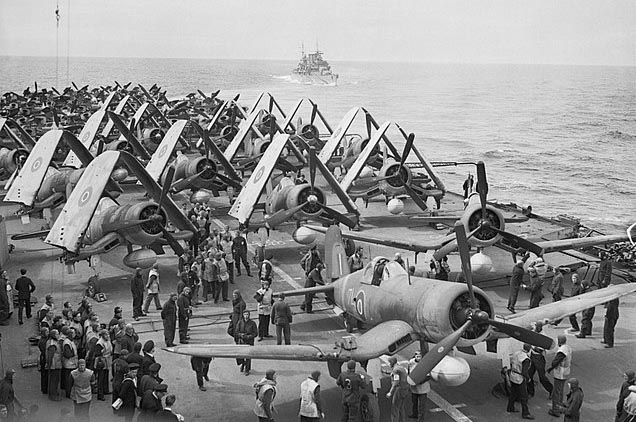
Corsair and Barracudas on HMS_FORMIDABLE off Norway, July 1944
In October 1943, she was back to the Home Fleet via Gibraltar, arriving in Greenock on 13 October with HMS King George V. From Scapa Flow week later she started a cycle of ASW patrols to Iceland with Howe and Anson, plus fellow USN carrier Ranger, for three weeks. On 13 November she headed for Belfast withouit her air group for another refit, starting on 19 November. By early June she was ready and trained fo several weeks, taking onboard newly delivered Corsairs of 1841 Squadron (18) and 24 Barracudas (827-830 Sqns) on 29 June. HMS Formidable ws back to Scapa Flow for more training with HMS Furious and Indefatigable. This was all in preparation of a first air attack on KMS Tirpitz in Kaafjord: 17 July Operation Mascot. Corsairs took off in escort to the Barracudas of all three carriers. One was shot down (flak) en route, but upon arrival, the Battleship was hidden by a massive smoke screen. No hit was scored. 827 and 830 Squadrons were replaced by 826 and 828 Squadrons (Barracudas too) as she went back.
She later received Corsairs of 1842 Squadron (7 August) and was prepared for the next attack, Operation Goodwood. The first attack started on 22 August at dawn, Formidable launching 24 Corsairs and 12 Barracudas. Again, a smoke screen was hiding Tirpitz. Another attack was cancelled because of bad weather and the next. Another was made on 24 August with 23 Corsairs and 16 Barracudas (3 Corsairs shot down) but this time, they hit Tirpitz, only was lightly damaged by two bomb. The sixth attack five days later failed. It was decided to put an end to these tactics and attempt instead other ones, hig altitude bombing with “Grand Slam” ordnance, which succeeded this time.
Formidable’s Pacific campaign
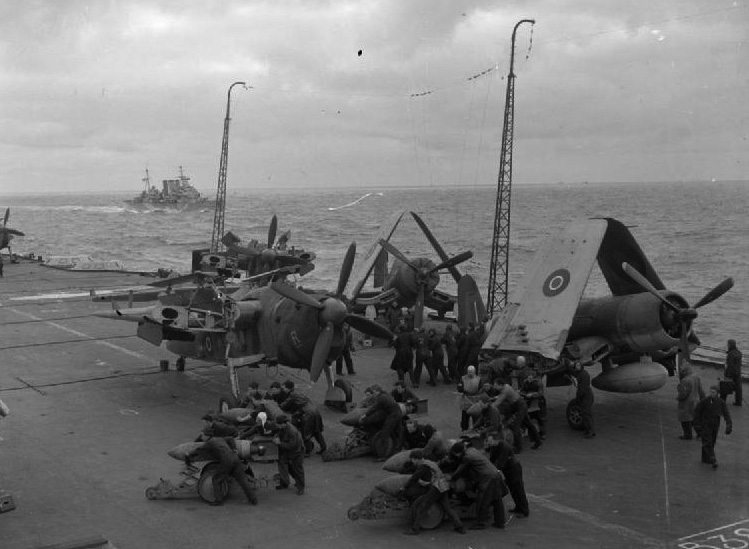
Fairey Barracuda and Vought F4U Corsair, Operation Goodwood HMS Formidable
Back to Scapa Flow on 2 September 1944, Formidable landed her Barracuda squadrons. She was ordered to Gibraltar (21 September), refitted with an increase of AA and prepared to depart for the Pacific. She carried Corsairs of No. 6 Naval Fighter Wing and 18 Grumman TBF Avengers (848 Squn) and after training, departed Gibraltar on 14 January to join the newly created BPF. She reached Sydney on 10 March 1945 and on the 20th she hosted Admiral Sir Bruce Fraser.
Her air group now reache dits peak with flight deck parked planes, so 36 Corsairs and 18 Avengers. From San Pedro Bay (Philippines) on 4 April she waited for the return of the BPF from a raid on the Sakishima Islands, between Okinawa and Formosa. HMS Formidable six days joined the 1st Aircraft Carrier Squadron, BPF oas replacement for HMS Illustrious plagued by machinery problems. On 14 April she launched her planes and recommenced two days later. While attacking Nobara airfield she lost a squadron commander. On 20 April she headed for San Pedro Bay to replenish and was back off Okinawa on 4 May.
Still tasked to attack the Sakishima Islands under Vice-Admiral Bernard Rawlings but soon recalled as was detached King George V and Howe plus five cruisers, to shell instead Nobara and Hiara airfields. Available fighters provided a CAP around and do some spotting.
Busy with her air group operations, Formidable had 11 Avengers moved forward to free the deck for landing, when as a sudden a low-flying Mitsubishi A6M Zero zeoed in on her at 11:31. After strafing her flight deck she turned sharply to aim at her forward flight deck, just as the carrier hard turned to starboard. It dropped a bomb but was destroyed by its own blast, its debris hitting the carrier.
This was severe: The flight deck was torn open over 24 feet-20 feet, 2 feet deep, the armour pierced through over 2 square feet. 2 officers and 6 ratings were killed, 55 wounded and a fragment also penetrated the hangar deck armour in the centre boiler uptake and entered the boiler room, then an oil tank, severing steam pipes, forcing the evacuation of the center boiler room. She ship saw her top speed down to 14 knots. An Avenger was obliteraded and another burned while Shrapnel peppered the island.
The electrical network was also shattered ans she lost her radars. Fortunately the hangar’s fired were extinguished by 11:55, destroying however seven Avengers and a Corsair. The bomb hit also was so lucky that it disjointed three armour plates, dented plates over 20-24 feet, later filled by wood and concrete, with thin steel plates welded above.
Her deck was still operationa however, allowing to recuperate aircraft at 17:00. The machinery team did wonders and she was able soon to run at 24 knots. During the attack she had 13 Corsairs airborne, and they landed on the other carriers for the time of repairs. The next day the center boiler room was operational again.
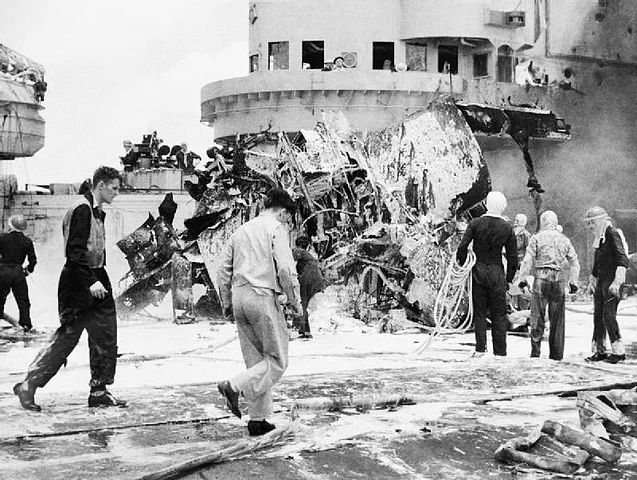
Kamikaze damage on HMS FORMIDABLE off Sakishima Islands May 1945
On 5 May attacked calmed down while Formidable’s Corsairs, operating from Victorious, shot down a very high Japanese reconnaissance aircraft. Refuelling, she was back on station on 8 May. Heavy rains postponed air strikes and on 9 May a lone kamikaze pilot (Yoshinari Kurose) also flying at low altitude to avoid detection by CAPs crashed on Formidable’s flight deck. It was 17:05 and fortunately, the plane was not carrying a bomb. It just “splashed” on the park but the explosion and large fire destroyed 18 of these parked aircraft caused one killed, four wounded. Fire was quickly mastered and deamaged planes thrown overvoard so she could resume operations a mere fifty minutes later.
Of her deck part, four Avengers and eleven Corsairs were recuperated and still serviceable. However she was withdrawn by order, replaced by Victorious. She sailed for repairs and replenishinh her air groups. Meawnhile instructions were given to deal with the new Japanese low-level tactics. Battleships and cruisers wee stationed closer to the carriers, having lower AA, more able to detect and deal with these Kamikaze. Radar picket cruisers were also posted in possible attack ways.
Back to action on 12 May, Formidable’s Avengers landed aboard Indomitable and the routine of operations went on, with resplenishments in between. On 18 May, as ammunition was loaded into an Avenger, a Corsair’s guns accidentally fired into hit and the latter caught fire. Fire sprinklers failed to extinguish the fire, that raged for nearly an hour, partly due to the failured of electric motors driving the steel fire curtains. 21 Corsairs 7 Avengers were damaged or destroyed as the result and Rear Admiral Rawlings decided to send Formidable to Sydney for more extensive repairs. She departed on 22 May 1945, arrived on 31 May at Captain Cook Dock. Two armour plates were repaired the third replaced by a sandwich of two 1.5-inch STS plates, the only available in Australia. The machinery, boilers and electrical systems were repaired and overhauled. The island was enlarge also to serve a flagship with admiral’s staff cabin, radar workshop. She in fact became flagship indeed for Rear-Admiral Sir Philip Vian when her overhaul was complete.
Convoy of repatriated POWs in October 1945
She sailed from Sydney on 28 June 1945 with HMS Victorious and King George V for Manus Island, the allied advanced base of the Admiralty Islands. She carried a renewed air group of 36 Corsairs, 12 Avengers and 6 Grumman F6F Hellcats (1844 Sqn, newly arrived), including two photoreconnaissance versions. This force fell under command of the 2nd Carrier Air Group. They joined the US Third Fleet in operation off the Japanese Home Islands.
Formidable met them on 16 July, commencing operations. She operated north of Tokyo, with mixed results due to bad weather. Operations were halted until 24–25 July. Attacked on Osaka and the Inland Sea followed, her air group badly damaging the escort carrier IJN Kaiyo. On 28 and 30 July the escort destroyers Okinawa near Maizuru were sunk, but bad weather and periods of refuelling had operations resumed on 9 August.
HMS Formidable flew off a dozen Corsairs and Avengers over Matsushima Air Field and a second attacked Japanese warships in Onagawa Wan. Two escort ships of the Etorofu-class were spotted, and IJN Amakusa was sunk. Commander Gray however died in the attack, later posthumously awarded the Victoria Cross. Two more warships and small merchantmen were destroyed. Corsairs also attacked the railways, destroying locomotives and parked aircraft as well. The BPF withdrawn on 10 August, in order to prepare for Operation Olympic, in Manus, but on the 15, ceasefire halted operations.
HMS Formidable headed for Sydney on 24 August, her hangar modified to carry allied POWs and soldiers. Her air group was landed to make room for these msisions. She was in Manila on 30 September for another run home with 1,000 Australian POW. Three days later she made another run in Karavia Bay (New Britain) with 1,254 Indian Army troops, and stopped in Singapore to load Indian PoWs, reaching Bombay. She also embarked an Indian Army infantry battalion for the occupation of Batavia until the Dutch colonial troops arrived. The 7th Australian Division from Tarakan Island in Borneo and Morotai were carried back to Sydney on 6 December 1945.
She was visited by Vice-Admiral Vian on 27 December an departed for home with 800 extra naval personnel. She was gteeted at her return in Portsmouth on 5 February 1946. The hangar was refitted to carry even more troops and she loaded 480 personnel and headed for Sydney, arriving on 2 April. She carried 1,336 naval personnel, Wrens and VAD nurses to Colombo, refuelling and dropping personnel, and back to Devonport (9 May 1946). She made another run to Bombay and Colombo until 25 July, Singapore in August, Trincomalee, Malta and back home, then a last Portsmouth-Singapore run with 1,000 Royal Marine Commandos onboard. This was over on 3 February 1947. By March 1947 she was set to Rosyth for a brief refit and placed in reserve, paid off on 12 August. A survey showed her wartime damage was too extensive for modernization. She stayed idle for a possible sell or conversion, but due to budget restruction, was sold for scrap in January 1953 and BU later.
HMS Victorious
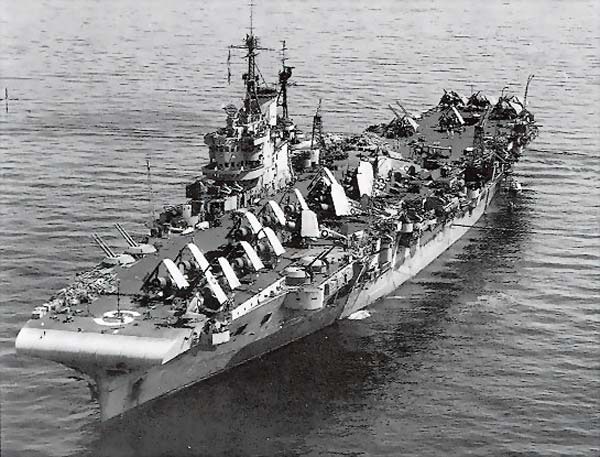
Bismarck’s chase
Two weeks after her commission in May 1941, HMS Victorious hunted the Bismarck, unleashed in the North Atlantic. She was originally sailing with the Convoy WS 8B to the Middle East, but was detached and sent in pursuit even though she was far from ready with just a quarter of her air group on board, and hardly trained. She joined HMS King George V, HMS Repulse and 4 light cruisers as the southern part of the pincer.
On 24 May 1941, she launched nine Fairey Swordfish assisted by two Fulmar. The “Stringbags” flew under command of Eugene Esmonde. They went through heavy weather, spotted and attacked Bismarck in a storm of AA fire, and scoring a hit to her armoured belt. Amazingly enough, no aircraft was shot down, but the Fulmars were too far away to make it back and ditched at sea, running out of fuel as they ould not locate the Victorious’s homing beacon, which failed. But this was over for her at that point, more experienced pilots from Ark Royal eventually hit and jammed the Reich’s might battleship’s steering gear, but Esmonde received a DSO anyway.
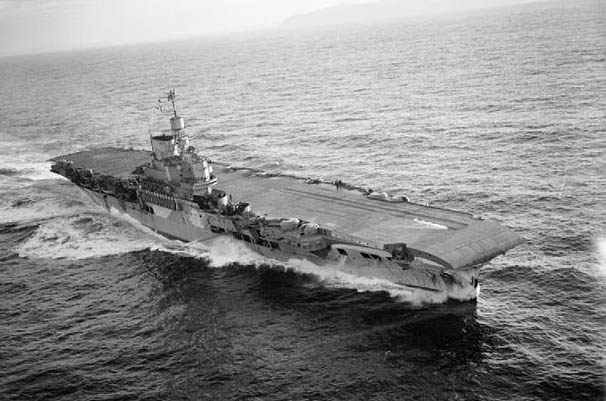
Aerial photography of HMS Victorious, 28 October 1941
Convoys and Northern Operations
In early June 1941, Victorious escorted the troop convoy WS 8X when one of her Swordfish (825 Sqn) airborne and patrolling, located the German supply ship Gonzenheim, north of the Azores. This was the mid-atlantic intended supplier for Bismarck. She scuttled as British warships approached. On 5 June, Victorious was ordered to Gibraltar with Ark Royal, her mission being to carry and fly-off Hawker Hurricanes to Malta, Operation Tracer. Her mission accomplished, she returned to Scapa Flow with the captured crew of Gonzenheim. By late July 1941, she escorted the minelayer cruiser HMS Adventureto Murmansk, carrying mines. On 31 July she was back west, participated on the raid on Kirkenes and Petsamo, but greeted by a temendous AA and Luftwaffe defence. She lost 13 aircraft for this operation. By late August, Victorious escorted the first Allied convoy to Archangel, Operation Dervish with a strong escort, then covered the return of HMS Argus delivering Hurricanes to Murmansk. She launched air attacks later on Tromsø, Vestfjorden, and against shipping off Bodø, and on 13 September, her air group sank the Norwegian steamer Barøy.
In October 1941 Scheer and Tirpitz were signalled by Bletchley Park poised to make a sortie and Victorious sailed for the Denmark Strait with HMS King George V, USS Idaho and USS Mississippi, the cruisers USS Wichita and USS Tuscaloosa. It happened while tere was still no formal state of war between the United States and Germany. This fleet staye din postion until mid-November in international waters, and Hitler cancelled the operation. Victorious returned with the Home Fleet until March 1942.
She was back later to Arctic Convoys protection in March-April 1942. She provided cover for convoys PQ 12, QP 8, PQ 13, QP 9, PQ 14, and QP 10 and launched an air strike on Tirpitz, losing two aircraft for no result. From April to June, allied naval fleet now comprising also USS Washington, Tuscaloosa, and Wichita covered convoys PQ 16, QP 12, PQ 17, and QP 13. Victorious was back to Scapa Flow for a refit.
Suspension of convoys after the losses of PQ 17 put an end to these operations for a time. Butthis was a chance for the British aircraft career to shine in a more glamorous theater of operations: The Mediterranean.
Operation Pedestal (August 1942)
Victorious headed in a “last chance” convoy to the besieged Malta, called Operation Pedestal. The convoy named WS 21S departed Britain on 3 August 1942. The escort comprised HMS Victorious, HMS Nelson, and the cruisers HMS Nigeria, Kenya and Manchester. Operation Berserk was a serie of exercizes combining the air groups of HMS Indomitable, Furious, Eagle and Argus plus Victorious, perfecting defesive and attack techniques.
The operation took place in 10 August 1942, seeing the deployment of 2 battleships, 4 aircraft carriers, 7 cruisers and 32 destroyers. The carriers had their flight deck full of reinforcement aircraft for Malta’s depleted airfields. Fourteen merchant ships also carried much-needed supplies. On 12 August 1942 HMS Victorious was attacked by Italian SM.79, and apparently took a near-miss. HMS Eagle was torpedoed and sunk by an U-boat while back io Gibraltar but Pedestal succeeded as all supplies plus Spitfires arrived in Malta, although nine merchant ships as well as two cruisers and a destroyer were sunk in action.

HMS Victorious & USS Saratoga, Noumea 1943
Operation Torch
Leaving the Mediterranean for Scapa Flow, Victorious trained in September-October for new missions. In November 1942, she was prepared to take part in Operation Torcch, the North African landings departing the 18th. En route, her Fairey Albacores (817 Sqn) depth charged and sunk U-517 off Cape Finisterre. She was part of an armada of 196 ships (RN) 105 of the USN. She provided air cover during the landings and made opportunity attacks on Algiers and Fort Duree. When this was over she returned home, waiting for more instructions. This time she was to be sent to the Pacific.
Reinforcing the USN – Pacific war
A USS Hornet was sunk, USS Enterprise badly damaged at Santa Cruz Islands, USS Saratoga remained as an operational carrier in the Pacific and by late December 1942, this led the USN to take an unprecedented step, asking to loan HMS Victorious to the US Navy, follwing a plea for carrier reinforcement. The RN accepted and the ship benefited a refit in the United States a(Norfolk NyD) in January 1943, receiving Avenger aircraft, and headed east via Panama on 14 February 1943 in order to reach Pearl Harbor. Her crew en route however suffered an outbreak of diphtheria.
She reached Pear on March 1943 and was equipped with US style, stronger arrester wires for the Grumman Avenger. She also obtained additional AA, Bofors and 20 mm Oerlikon. Heading the south-west Pacific, she anchored in Nouméa, New Caledonia (17 May), assigned to Carrier Division 1 with USS Saratoga. She sortied with Task Force 14 escorted by USS North Carolina, Massachusetts, and Indiana, looking for Japanese ships. Six aircraft were lost to accidents however, leading to some readjustments to carrier operations with the new Avengers.
Rear Admiral DeWitt Ramsey carried out evaluation exercises and patrol sweeps in June 1943. The report showed Victorious had a superior fighter control but poor Avenger management because of their weight. The 832 Sqn was transferred to USS Saratoga in exchanged of Carrier Air Group 3 on Victorious, composed of fighters. Victorious from there became tasked exclusively of fighter cover, Saratoga of strikes.
On 27 June 1943, TF14 became Task Group 36.3, and sailed to provide cover for the invasion of New Georgia, Operation Cartwheel. HMS Victorious spent 28 days in continuous day and night operations, a record for a British carrier at the time, with 614 sorties. She resplenished at Nouméa on 25 July before making it back home as in between the USN was reinforced by the first Essex-class and Independence class CVs.
Victorious transited via Pearl Harbor on 31 July and sailed with USS Indiana, launching ASW sweeps nderway and carrying to the US, pilots and two Japanese POWs. She stopped in San Diego, transited via the Panama Canal (26 August) arrived at Norfolk on 1 September, seeing her US equipment removed and arrived at Greenock on 26 September. She was scheduled for a refit.
Attacks on Tirpitz
From December 1943 to March 1944, Victorious was refit at Liverpool. A new radar was fitted and other minor modifications done, and after post-refi trials and training she sailed east with HMS Anson and Duke of York as “Force 1” to escort Convoy JW 58. On 2 April 1944 it was merged with Force 2 (HMS Furious, HMS Emperor, Fencer, Pursuer, Searcher, cruisers and destroyers). This fleet was mobilized off Norway for the first attack on Tirpitz, Operation Tungsten then in Altafjord. Barracudas were launched in two waves. They hit her battleship 17 times and made many near-misses. Damage was extensive but t no point Tirpitz’ armor was penetrated not vitals hit. But at least she was put out of actions for months.
This was followed by three further attacks in April and May 1944, namely Operations Planet, Brawn, and Tiger Claw, the last cancelled due to bad weather. On 30 May Victorious was torpedoed underway by an acoustic model launched by U-957, but it failed. Victorious reached her operation area and launched striked on merchant traffic Operation Lombard.
Late service with the BPF (July 1944-January 1945)
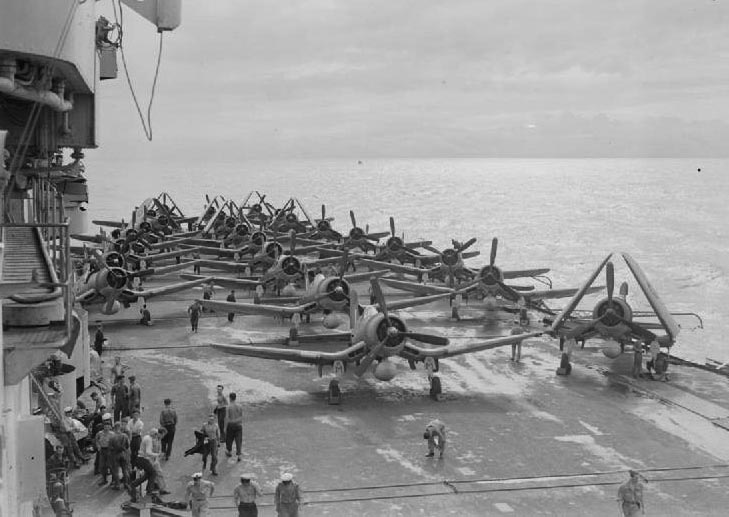
Vought Corsairs of 1834 and 1836 Squadrons onboard victorious, during the attacks on sigli and sumatra
In June 1944, HMS Victorious and HMS Indomitable, left home waters for Colombo, the British eastern fleet, reached on 5 July. She was prepared for a new offensive against the Japanese in the far east, starting with Operation Crimson on 25 July (with HMS Illustrious) on Sabang (Sumatra) adnd later provided cover for air-sea rescue again over Sumatra Operation Boomerang. On 29 August with her sisters HMS Illustrious and Indomitable, the battleship HMS Howe, she launched strikes on Padang, Indaroeng and Emmahaven, called Operation Banquet. On 18 September, Victorious and Indomitable attacked railways at Sigli (Sumatra) and photo-reconnaissance of the Nicobar Islands, Operation Light. She had a “friendly fire” on HMS Spirit during operations, with little damage. By late September, she was resuppluied and maintained at Bombay. Her capricious steering gear was repaired notably. Bck to the eastern fleet on 6 October she took part in Operation Millet her last. On 17 October she launched separate a raid on Nicobar Islands and Nancowry harbour with HMS Indomitable and HMS Renown. Bu early November she was back to Bombay shipyard, again working out her steering.
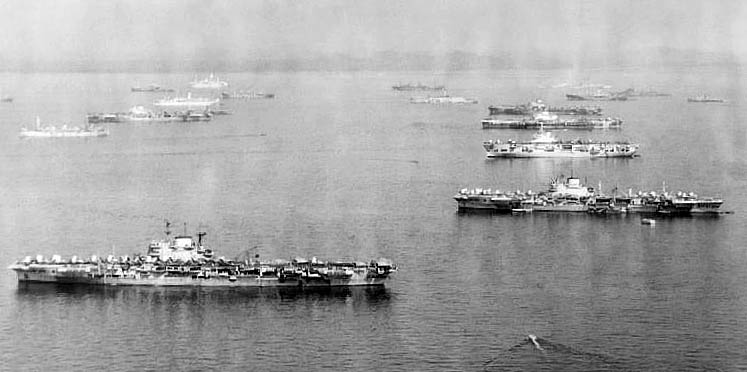
British aircraft carriers at ancho with the BPF in 1945
In between the eastern fleet was renamed and reorganized as the British Pacific Fleet (BPF) in Trincomalee, on 22 November 1944. From November 1944 until January 1945 she operated with the BPF in the Indian Ocean, notably training for a closer cooperation with the United States Navy. victorious was still however in drydock by January 1945, missing the raids on Pangkalan Brandan. By early January 1945, she took part in Operation Lentil, a raid on the oil refineries at Pangkalan Brandan with Indomitable and Implacable. Operations over Sumatra went on by 16 January and until later that month. Victorious left the BPF for Sydney, making underway extra raids on Pladjoe and Manna, south west Sumatra (Operation Meridian) and on 29 January, against Soengi-Gerong.
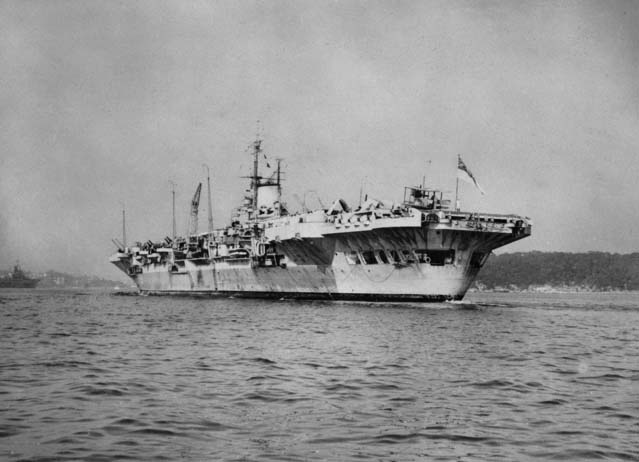
HMS Victorious arriving at Sydney in February 1945
Victorious at Okinawa
By early February, she joined Task Force 113 at Sydney, and depatrted to join the US 5th Fleet, stopping at Manus Island (New Guinea) and reaching her gathering point with TF 113 at Ulithi on 25 March 1945. This became Task Force 57, bound for Okinawa. The British force had to protect the flank of the invasion fleet, by attacking airfields in Sakishima Gunto. Until 25 May with Illustrious, then Formidable, Indefatigable and Indomitable, the armored carriers formed the 1st Aircraft Carrier Squadron (Vice Admiral Philip Vian) in continuous action over Sakishima Islands and Formosa Operations Iceberg.
Kamikaze attacked also threatened Victorious. She was hit on 4 and 9 May, near-missed on 1st April. Each time, her armoured flight deck hold on. She remained opetational, repairing damage on ther flight deck, aircraft lift, steam piping, and superstructure. She also had 3 killed, 19 wounded, but was lucky compared to her sister ships.
After May 1945, the BPF retired to Sydney and Manus. Victorious, Formidable and Indefatigable were also repaired. On 16 July theu departed however with the US 3rd Fleet, absorbed into TF38. Their mission until the end of the war was to reduce to nil Japanese home islands assets. Until mid-July Victorious attacked Japanese shipping and airbases on Honshu and the Inland Sea. IJN Kaiyo was notably badaly damaged in Beppu Bay, Kyūshū. After atomic bombs were dropped, missioned went on until Japan surrendered on 15 August. HMS Victorious left for Manus with TF37 on 12 August. She headed for Sydney, preparing for Operation Olympic but the BPF commander estimated steering faults hampering Victorious were a serios issue and she was to be sent home instead. On 31 August her company took part in the Victory Parade in Sydney. She left Australia in September 1945, arrived on 27 October home, making afterwards three trips to collect servicemen and war brides from Australia and the Far East. By the winter of 1946–47 deck trials were performed with the Hawker Sea Fury Mark 10s and so she resumed operations with it. Reduced to the reserve at Devonport on 15 January 1947 she was massively rebuilt from 1950, but that’s anotehr story.
HMS Indomitable
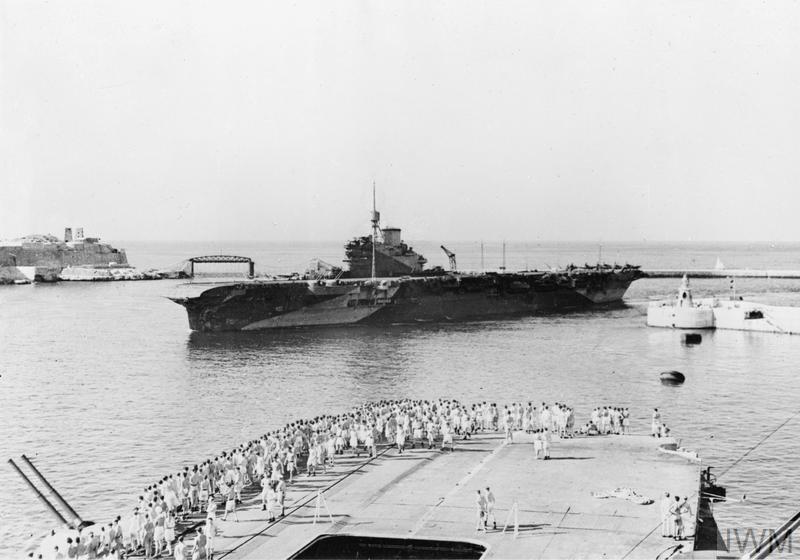
HMS Formidable in Malta, October 1943.
HMS Indomitable was completed much later after her launch, on 10 October 1941 and sailed to the West Indies in November 1941. This was her maiden voyage and shakedown cruise. However she ran aground on a coral reef near Jamaica, without much damage however. Due to this event she missed the opportinuty to joing Force Z sailing to Southeast Asia and deter Japanese aviation in Singapore. Shoe could have saved indeed, Repule and PoW during this fateful mission. In January 1942, HMS Indomitable joined the Eastern Fleet in Ceylon and ferried 48 Royal Air Force Hawker Hurricanes to airfields in Sumatra in the Dutch East Indies. They were inteded for Singapore but most were simply destroyed on the ground in air attacks, and the city and island surrendered on 15 February. With still Hong Kong and Burma to protect, HMS Indomitable was redeployed with a newly built eastern fleet under command of Admiral Sir James Somerville. She operated with HMS Formidable, quite an asset to the Allies there, as the third available, HMS Hermes, was obsolete and used as transport.
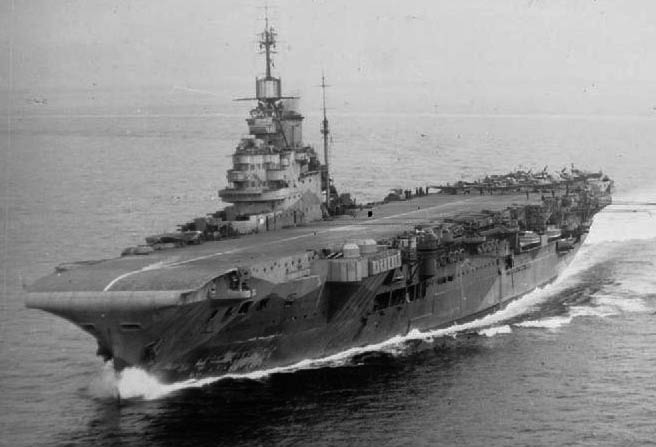
HMS Indomitable underway, 1943
In April 1942, an interception was attempted of the Kido Butai en route to rampage in the Indian Ocean and eliminating remaining British forces there. However incomplete intelligence had Force A refuelling when the Japanese arrived. Later Formidable was deployed with her radar-equipped Swordfish, for a night strike, successful strike but the seach went nowhere and Somerville folded down to Bombay. However in bwteen the Japanese sunk Hermes, HMAS Vampire, HMS Hollyhock, Cornwall and Dorsetshire, plus many merchant ships and wrecked port installations at Trincomalee and Ceylon.
But Indomitable was mobilized to take part in Operation Ironclad and detached from the Eastern Fleet to join the covering force with her sister ship Illustrious. They escorted the troopships from Durban until reaching on 5 May Courrier Bay, close to Diego Suarez. Indomitable destroyed Vichy French Arrachart airfield and its five Morane-Saulnier M.S.406 fighters plus two Potez 63.11s bombers. Her Albacores the following day pounded defensive lines and bunker, while Fulmars and Sea Hurricanes strafed everything on sight. Diego Suarez surrendered on 7 May but the following day, the submarine Monge was in torpedo range of Indomitable when she was located and sunk by depth charges from HMS Active and Panther.
In July 1942 she returned to home waters, refitted and prepared to return in the Mediterranean, Gibraltar, for Operation Pedestal. She escorted HMS Furious launching her Spitfires as reinforcement to Malta and supply ships to reach the city under siege on 11 August. During the cover, Indomitable was attacked by Ju 87s from StG 3. They get through the CAP and AA and two scored hits, logding two 500 kg bombs plus three near misses. On impacted just on the unarmoured portion of the flight deck. It caused quite extensive damage, but the second “splashed” on the armour and did not cause much concerns. However she was ordered out for repairs, still making 28.5 knots two hours after the attack, which left 6 officers and 40 sailors dead, 70 wounded. She sailed to the US for extensive repairs, completed in February 1943, making it back to the Mediterranean with more AA and a reinforced air group.
While on mission, she was attacked by Italian SM.79 (204a Squadriglia) or a Ju 88 bomber according to other sources, on 16 July while en route for the meeting point before Operation Husky. Badly damaged again she was back to the same yard for repairs lasting until 10 April 1944, when she started post-refit trials.
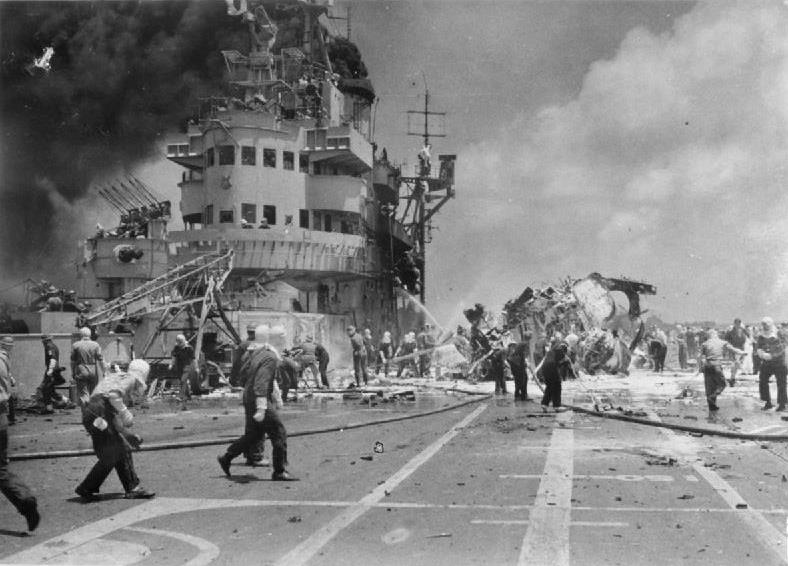
However by that point, apart landing operations in Italy, there was little to do but in the far east, where the situation was still tense. HMS Indomitable was ordered to return to the Eastern Fleet with HMS Victorious. They launched raids against Sumatra (August-September 1944), Nicobar Islands, and with HMS Illustrious, Medan and Sumatra on 20 December. In 1945 she was now part of the new British Pacific Fleet, and on 4 January 1945 with Victorious and Indefatigable, they raided Medan, Palembang, Sumatra. On 4 May 1945 during combined allied operations for the mastery of the sector surrounding okinawa, she was hit by a kamikaze. The latter had no bomb and crashed on her armoured flight deck. Aparts burned park planes, damage was light and she was operational again within hours. By August 1945 she supported the liberation of Hong Kong, covering the land party from HMCS Prince Robert and taking the Japanese surrender. Her last combat missions in this sector ended on 31 August. However untol 1 September her planes tracled suicide boats still running sorties against British forces.
Back to home waters in November 1945 she carried the national rugby league to Australia, making also her first post-war tour. In 1947, she was placed in reserve. A commission studied her case and estimated war damage was light enough to justify a long refit and modernization, from 1947 to 1950. But the rest of this story is reserve for the dedicated cold war page.








 Latest Facebook Entry -
Latest Facebook Entry -  X(Tweeter) Naval Encyclopedia's deck archive
X(Tweeter) Naval Encyclopedia's deck archive Instagram (@navalencyc)
Instagram (@navalencyc)





 French Navy
French Navy Royal Navy
Royal Navy Russian Navy
Russian Navy Armada Espanola
Armada Espanola Austrian Navy
Austrian Navy K.u.K. Kriegsmarine
K.u.K. Kriegsmarine Dansk Marine
Dansk Marine Nautiko Hellenon
Nautiko Hellenon Koninklije Marine 1870
Koninklije Marine 1870 Marinha do Brasil
Marinha do Brasil Osmanlı Donanması
Osmanlı Donanması Marina Do Peru
Marina Do Peru Marinha do Portugal
Marinha do Portugal Regia Marina 1870
Regia Marina 1870 Nihhon Kaigun 1870
Nihhon Kaigun 1870 Preußische Marine 1870
Preußische Marine 1870 Russkiy Flot 1870
Russkiy Flot 1870 Svenska marinen
Svenska marinen Søværnet
Søværnet Union Navy
Union Navy Confederate Navy
Confederate Navy Armada de Argentina
Armada de Argentina Imperial Chinese Navy
Imperial Chinese Navy Marinha do Portugal
Marinha do Portugal Mexico
Mexico Kaiserliche Marine
Kaiserliche Marine 1898 US Navy
1898 US Navy Sovietskiy Flot
Sovietskiy Flot Royal Canadian Navy
Royal Canadian Navy Royal Australian Navy
Royal Australian Navy RNZN Fleet
RNZN Fleet Chinese Navy 1937
Chinese Navy 1937 Kriegsmarine
Kriegsmarine Chilean Navy
Chilean Navy Danish Navy
Danish Navy Finnish Navy
Finnish Navy Hellenic Navy
Hellenic Navy Polish Navy
Polish Navy Romanian Navy
Romanian Navy Turkish Navy
Turkish Navy Royal Yugoslav Navy
Royal Yugoslav Navy Royal Thai Navy
Royal Thai Navy Minor Navies
Minor Navies Albania
Albania Austria
Austria Belgium
Belgium Columbia
Columbia Costa Rica
Costa Rica Cuba
Cuba Czechoslovakia
Czechoslovakia Dominican Republic
Dominican Republic Haiti
Haiti Hungary
Hungary Honduras
Honduras Estonia
Estonia Iceland
Iceland Eire
Eire Equador
Equador Iran
Iran Iraq
Iraq Latvia
Latvia Liberia
Liberia Lithuania
Lithuania Mandchukuo
Mandchukuo Morocco
Morocco Nicaragua
Nicaragua Persia
Persia San Salvador
San Salvador Sarawak
Sarawak Uruguay
Uruguay Venezuela
Venezuela Zanzibar
Zanzibar Warsaw Pact Navies
Warsaw Pact Navies Bulgaria
Bulgaria Hungary
Hungary

 Bundesmarine
Bundesmarine Dutch Navy
Dutch Navy Hellenic Navy
Hellenic Navy Marina Militare
Marina Militare Yugoslav Navy
Yugoslav Navy Chinese Navy
Chinese Navy Indian Navy
Indian Navy Indonesian Navy
Indonesian Navy JMSDF
JMSDF North Korean Navy
North Korean Navy Pakistani Navy
Pakistani Navy Philippines Navy
Philippines Navy ROKN
ROKN Rep. of Singapore Navy
Rep. of Singapore Navy Taiwanese Navy
Taiwanese Navy IDF Navy
IDF Navy Saudi Navy
Saudi Navy Royal New Zealand Navy
Royal New Zealand Navy Egyptian Navy
Egyptian Navy South African Navy
South African Navy






























 Ukrainian Navy
Ukrainian Navy dbodesign
dbodesign